 Ciliwung and Cisadane River, Indonesia in a Brink of Destruction
Ciliwung and Cisadane River, Indonesia in a Brink of Destruction
2012-03-10, 8:25 pm
I found an journal:
STUDI BIOTA PERAIRAN DAN HERPETOFAUNA Dl DAERAH ALIRAN SUNGAI (DAS) CILIWUNG DAN CISADANE: KAJIAN HILANGNYA KEANEKARAGAMAN HAYATI
(Aquatic Biota Herpetofauna Study in Ciliwung and Cisadane Streams: Study of Biodiversity Loss)
by Dr. Ir. Daisy Wowor, M.Sc
year: 2010
You can download the original .pdf from here:
http://www.mediafire.com/?k59029lhc2u8sls
---------------------
J'ai trouvé un journal:
STUDI BIOTA PERAIRAN DAN HERPETOFAUNA Dl DAERAH ALIRAN SUNGAI (DAS) CILIWUNG DAN CISADANE: KAJIAN HILANGNYA KEANEKARAGAMAN HAYATI
(Biote aquatique Herpétofaune étude dans les flux de Ciliwung et Cisadane: Etude de la perte de biodiversité)
by Dr. Ir. Daisy Wowor, M.Sc
année: 2010
Vous pouvez télécharger le pdf d'origine à partir d'ici.:
http://www.mediafire.com/?k59029lhc2u8sls
=====================================
1. Introduction
Ciliwung and Cisadane which are two main rivers found in West Java around the most metropolize area in Indonesia, JaBoDeTaBek (abbreviation from: Jakarta, Bogor, Depok, Tangerang, Bekasi)
-----
Ciliwung et Cisadane qui sont deux rivières principales trouvées dans l'ouest de Java autour de la zone la plus metropolize en Indonésie, JaBoDeTaBek (abréviation de: Jakarta, Bogor, Depok, Tangerang, Bekasi)
Ciliwung:
Cisadane:
Due to the high population in those metropolitan area, rapid urban developement has occurred over the function at some ponds contained in the watershed are participating also affect the ecological watery system. From their research, they found 9 species of crustacea, 23 species of fish, 5 species of amphibians, and 20 species of reptiles from Ciliwung streams. And from Cisadane Streams, they found 6 species of crustacea, 31 species of fish, 8 species of amphibians, and 24 species of reptiles.. From both streams, some of the unfound species from 2009 were find, but some of the species that were found in 2009 were not found in 2010. There were even some invasive species on both rivers. As for the fish, this result will show that there were some fish that has now extinct from their habitat, but they couldn't be sure from reptiles and amphibians population because they are just count them in year 2010 and never before.. The loss of crustacea species and fish in some pond and Ciliwung stream are 60% and 84,5%; and in Cisadane Stream the loss of crustacea and fish are 20% and 74,4%.. The extinction of these aquatic faunas was caused by some changes functions of the river ponds and poor water quality due to disposal of municipal waste from house industry. Some of the riverside had become human settlemant, toll road, and many others.
-----------------
En raison de la population dans les régions métropolitaines, rapide Développement urbain a eu lieu au cours de la fonction à certains étangs contenues dans le bassin versant participent également affecter le système écologique aquatique. De leurs recherches, ils ont trouvé 9 espèces de crustacés, 23 espèces de poissons, 5 espèces d'amphibiens, et 20 espèces de reptiles dans les flux de Ciliwung. Et à partir de Streams Cisadane, ils ont trouvé 6 espèces de crustacés, 31 espèces de poissons, 8 espèces d'amphibiens, et 24 espèces de reptiles .. De deux cours d'eau, quelques-unes des espèces introuvables à partir de 2009 étaient à trouver, mais quelques-unes des espèces qui ont été trouvés en 2009 n'ont pas été trouvés en 2010. Il y avait même quelques espèces envahissantes sur les deux rivières. En ce qui concerne le poisson, ce résultat montre qu'il y avait un peu de poisson qui a maintenant disparu de leur habitat, mais ils ne pouvaient pas être sûr de la population reptiles et des amphibiens, car ils sont tout simplement les compter de l'année 2010 et jamais .. La perte d'espèces de crustacés et de poissons dans certains étangs et cours d'eau sont Ciliwung 60% et 84,5%, et dans le ruisseau Cisadane la perte de crustacés et de poissons sont de 20% et de 74,4% .. L'extinction de ces faunes aquatiques a été causée par certaines fonctions des changements des étangs des rivières et la qualité médiocre de l'eau en raison de l'élimination des déchets municipaux de l'industrie maison. Une partie de la rivière était devenue settlemant humaine, la route à péage, et bien d'autres.
The results from the research in the early to mid-20 th century has been recorded 18 species of native crustaceans and 187 species of native fish from Ciliwung stream. 23 species of native crustaceans and 135 species of native fish from Cisadane Stream (Holthuis, 1950; Wowor et al, 2009). The last data about water fauna that were collected in MZB show that since about 24 years ago, several kinds of crustaceans and fish have not been found again on both the streams. Several studies have been conducted by researchers from Puslitbang Biologi (Biology Research Centre), from Cisadane Stream (Rachmatika, 2003) and Ciliwung Stream in year 1991-1992. Research in the watershed of Ciliwung managed to obtain 19 native fish species, and data 44 species was found (Whitten et al, 1999) from the moment before Indonesia's independence (1945). Research and development potential of native fish in the JaBoDeTaBek area and it's water region were researched and reported by Hadiaty (2003).
Herpetofauna data listed in the MZB collection, Zoology, Research Center for Biologi LIPI includes 62 species of reptiles and 19 species of amphibian. Collecting specimens from 1903 to 1986. In addition, there had found a "worm-headed" amphibian, Ichthyophis hypocyaneus (Javan Caecillian).[1] This kind of amphibian class since its first description approximately 175 years ago had never been known until it was found again recently in 2000 (Pekalongan) and 2007 (Mount Gede Pangrango, Upperstream of Cisadane)[2], so these types of amphibian can be classified into types of endemic island of Java (Iskandar, 1998). Thus, to date no study is known about the loss of biodiversity of the fauna in their natural habitat.
----------------
Les résultats de la recherche dans le siècle début à la mi-20 a été enregistré 18 espèces de crustacés indigènes et 187 espèces de poissons indigènes de Ciliwung flux. 23 espèces de crustacés indigènes et 135 espèces de poissons indigènes de Stream Cisadane (Holthuis, 1950; Wowor et al, 2009). Les dernières données sur la faune d'eau qui ont été recueillies en show MZB que depuis environ 24 ans, plusieurs sortes de crustacés et de poissons n'ont pas été retrouvées sur les deux cours d'eau. Plusieurs études ont été menées par des chercheurs de Puslitbang Biologi (Biologie Research Centre), à partir de flux Cisadane (Rachmatika, 2003) et Stream Ciliwung l'année 1991-1992. La recherche dans le bassin versant de Ciliwung réussi à obtenir 19 espèces de poissons indigènes, et de données 44 espèces a été trouvé (Whitten et al, 1999) à partir du moment avant l'indépendance de l'Indonésie (1945). Le potentiel de recherche et le développement de poissons indigènes dans la région et la région JaBoDeTaBek l'eau, il a été étudié et rapporté par Hadiaty (2003).
Données herpétofaune énumérés dans la collection MZB, Zoologie, Centre de recherche pour Biologi LIPI comprend 62 espèces de reptiles et 19 espèces d'amphibiens. Collecte des échantillons de 1903 à 1986. En outre, il avait trouvé un "ver-tête« amphibien, Ichthyophis hypocyaneus (Javan Caecillian).[1] Ce genre de classe des amphibiens depuis sa première description d'environ 175 ans n'avait jamais été connu jusqu'à il a été constaté encore récemment en 2000 (Pekalongan) et 2007 (Mont Gede Pangrango, Upperstream de Cisadane)[2], de sorte que ces types d'amphibiens peuvent être classés en types de l'île de Java endémique (Iskandar, 1998). Ainsi, à ce jour aucune étude est connu au sujet de la perte de la biodiversité de la faune dans leur habitat naturel.
In different areas of Bogor, Tangerang, Depok, Bekasi and Jakarta there have been introduced a wide range of industrial with rapidly developing. As a consequence of growth industry to some extent, there have been changes made in land use patterns. According Roemantyo et al (2003), when compared to the years 1922-1943, there were about 42% of wetlands or stagnant water areas that form in small lake and swamps that have changed function to be used as land and residential and industrial land. From data that have been obtained from the Center for Ciliwung Cisadane River Region - Department for General Work, it was known that in 2008 there were 185 small lake in JaBoDeTaBek, 20 of them disappeared into residential areas, highways, fields and moor. Ciliwung
and Cisadane streams also represents an overview of the various watershed conditions in Indonesia are showing degradation of forest and environmental management.
----------------
Dans les différents domaines de Bogor, Tangerang, Depok, Bekasi et Jakarta ont été mis en place un large éventail de l'industrie qui se développe rapidement avec. En conséquence de l'industrie de croissance dans une certaine mesure, il ya eu des changements apportés dans les habitudes d'utilisation des terres. Selon Roemantyo et al (2003), par rapport aux années 1922-1943, il y avait environ 42% des zones humides ou des zones d'eau stagnante qui se forment dans un petit lac et des marais qui ont changé de fonction pour être utilisé comme terre terre et résidentiel et industriel. D'après les données qui ont été obtenus à partir du Centre pour la région de la rivière Ciliwung Cisadane - Ministère du Travail général, il était connu que, en 2008, il y avait 185 petit lac dans JaBoDeTaBek, 20 d'entre eux a disparu dans les zones résidentielles, des routes, des champs et des landes. Ciliwung
et les flux de Cisadane représente également un aperçu des différentes conditions des bassins versants en Indonésie montrent la dégradation des forêts et de la gestion de l'environnement.
From the results of the study in 2009 (Wowor et al), noting that as many as 92.5% Ciliwung river native fish and its tributaries have been lost. While the native fish from Cisadane river and it's tributaries have dwindled as much as 75.6%. The caused is non other that chemical pollution, land use patterns, and some invasive species..
---------
D'après les résultats de l'étude en 2009 (Wowor et al), notant que jusqu'à 92,5% des poissons de rivière Ciliwung natif et de ses affluents ont été perdus. Bien que le poisson originaire de Cisadane fleuve et ses affluents ont diminué autant que 75,6%.Le fait n'est autre que la pollution chimique, les modes d'utilisation des terres, et certaines espèces invasives ..
Reference:
1. Warta Herpetofauna Volume III No. 1 September 2009: http://xa.yimg.com/kq/groups/20809606/656337140/name/Warta+Herpetofauna+Edisi+September+2009.pdf
2. Encyclopedia of Life: http://eol.org/pages/333068/entries/34378857/overview
Next post will contain more on what species is found on the rivers..
STUDI BIOTA PERAIRAN DAN HERPETOFAUNA Dl DAERAH ALIRAN SUNGAI (DAS) CILIWUNG DAN CISADANE: KAJIAN HILANGNYA KEANEKARAGAMAN HAYATI
(Aquatic Biota Herpetofauna Study in Ciliwung and Cisadane Streams: Study of Biodiversity Loss)
by Dr. Ir. Daisy Wowor, M.Sc
year: 2010
You can download the original .pdf from here:
http://www.mediafire.com/?k59029lhc2u8sls
---------------------
J'ai trouvé un journal:
STUDI BIOTA PERAIRAN DAN HERPETOFAUNA Dl DAERAH ALIRAN SUNGAI (DAS) CILIWUNG DAN CISADANE: KAJIAN HILANGNYA KEANEKARAGAMAN HAYATI
(Biote aquatique Herpétofaune étude dans les flux de Ciliwung et Cisadane: Etude de la perte de biodiversité)
by Dr. Ir. Daisy Wowor, M.Sc
année: 2010
Vous pouvez télécharger le pdf d'origine à partir d'ici.:
http://www.mediafire.com/?k59029lhc2u8sls
=====================================
1. Introduction
Ciliwung and Cisadane which are two main rivers found in West Java around the most metropolize area in Indonesia, JaBoDeTaBek (abbreviation from: Jakarta, Bogor, Depok, Tangerang, Bekasi)
-----
Ciliwung et Cisadane qui sont deux rivières principales trouvées dans l'ouest de Java autour de la zone la plus metropolize en Indonésie, JaBoDeTaBek (abréviation de: Jakarta, Bogor, Depok, Tangerang, Bekasi)
Ciliwung:
- Spoiler:
View Larger Map
Move the map to the northwest.. Upstreams are located on the plateau which lies on the border of Bogor and Cianjur, or rather in Mount Gede and Mount Pangrango Peak area. After passing through the eastern city of Bogor, this river flows north, on the west side of Jalan Raya Jakarta-Bogor, Depok east side, and entered the Jakarta area as a natural border area of South Jakarta and East Jakarta.
-----
Déplacez la carte au nord-ouest ..Amonts sont situés sur le plateau qui se trouve sur la frontière de Bogor et Cianjur, ou plutôt à Mount Gede et le mont Pangrango surface de pic. Après avoir traversé la ville orientale de Bogor, cette rivière coule vers le nord, sur le côté ouest de Jalan Raya côté Jakarta-Bogor, Depok est, et entra dans la région de Jakarta en tant que zone de frontière naturelle de Jakarta-Sud et de l'Est de Jakarta.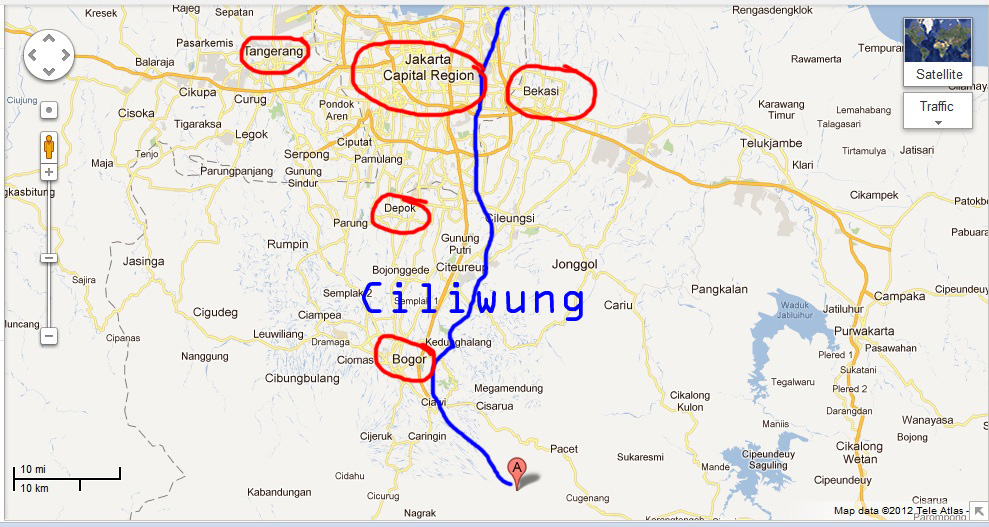
http://id.wikipedia.org/wiki/Ci_Liwung
Cisadane:
- Spoiler:
View Larger Map
Move the map to the northwest.. This is the upstream of Cisadane River continuing north crossing Tangerang City and make it's estuaries to Java Sea.
Here's the look of the river..
---
Déplacez la carte au nord-ouest .. Il s'agit de la rivière en amont de Cisadane continuant vers le nord traversée ville de Tangerang et de faire ses estuaires de la mer de Java.
Voici l'apparence de la rivière ..
http://id.wikipedia.org/wiki/Ci_Sadane
Due to the high population in those metropolitan area, rapid urban developement has occurred over the function at some ponds contained in the watershed are participating also affect the ecological watery system. From their research, they found 9 species of crustacea, 23 species of fish, 5 species of amphibians, and 20 species of reptiles from Ciliwung streams. And from Cisadane Streams, they found 6 species of crustacea, 31 species of fish, 8 species of amphibians, and 24 species of reptiles.. From both streams, some of the unfound species from 2009 were find, but some of the species that were found in 2009 were not found in 2010. There were even some invasive species on both rivers. As for the fish, this result will show that there were some fish that has now extinct from their habitat, but they couldn't be sure from reptiles and amphibians population because they are just count them in year 2010 and never before.. The loss of crustacea species and fish in some pond and Ciliwung stream are 60% and 84,5%; and in Cisadane Stream the loss of crustacea and fish are 20% and 74,4%.. The extinction of these aquatic faunas was caused by some changes functions of the river ponds and poor water quality due to disposal of municipal waste from house industry. Some of the riverside had become human settlemant, toll road, and many others.
-----------------
En raison de la population dans les régions métropolitaines, rapide Développement urbain a eu lieu au cours de la fonction à certains étangs contenues dans le bassin versant participent également affecter le système écologique aquatique. De leurs recherches, ils ont trouvé 9 espèces de crustacés, 23 espèces de poissons, 5 espèces d'amphibiens, et 20 espèces de reptiles dans les flux de Ciliwung. Et à partir de Streams Cisadane, ils ont trouvé 6 espèces de crustacés, 31 espèces de poissons, 8 espèces d'amphibiens, et 24 espèces de reptiles .. De deux cours d'eau, quelques-unes des espèces introuvables à partir de 2009 étaient à trouver, mais quelques-unes des espèces qui ont été trouvés en 2009 n'ont pas été trouvés en 2010. Il y avait même quelques espèces envahissantes sur les deux rivières. En ce qui concerne le poisson, ce résultat montre qu'il y avait un peu de poisson qui a maintenant disparu de leur habitat, mais ils ne pouvaient pas être sûr de la population reptiles et des amphibiens, car ils sont tout simplement les compter de l'année 2010 et jamais .. La perte d'espèces de crustacés et de poissons dans certains étangs et cours d'eau sont Ciliwung 60% et 84,5%, et dans le ruisseau Cisadane la perte de crustacés et de poissons sont de 20% et de 74,4% .. L'extinction de ces faunes aquatiques a été causée par certaines fonctions des changements des étangs des rivières et la qualité médiocre de l'eau en raison de l'élimination des déchets municipaux de l'industrie maison. Une partie de la rivière était devenue settlemant humaine, la route à péage, et bien d'autres.
The results from the research in the early to mid-20 th century has been recorded 18 species of native crustaceans and 187 species of native fish from Ciliwung stream. 23 species of native crustaceans and 135 species of native fish from Cisadane Stream (Holthuis, 1950; Wowor et al, 2009). The last data about water fauna that were collected in MZB show that since about 24 years ago, several kinds of crustaceans and fish have not been found again on both the streams. Several studies have been conducted by researchers from Puslitbang Biologi (Biology Research Centre), from Cisadane Stream (Rachmatika, 2003) and Ciliwung Stream in year 1991-1992. Research in the watershed of Ciliwung managed to obtain 19 native fish species, and data 44 species was found (Whitten et al, 1999) from the moment before Indonesia's independence (1945). Research and development potential of native fish in the JaBoDeTaBek area and it's water region were researched and reported by Hadiaty (2003).
Herpetofauna data listed in the MZB collection, Zoology, Research Center for Biologi LIPI includes 62 species of reptiles and 19 species of amphibian. Collecting specimens from 1903 to 1986. In addition, there had found a "worm-headed" amphibian, Ichthyophis hypocyaneus (Javan Caecillian).[1] This kind of amphibian class since its first description approximately 175 years ago had never been known until it was found again recently in 2000 (Pekalongan) and 2007 (Mount Gede Pangrango, Upperstream of Cisadane)[2], so these types of amphibian can be classified into types of endemic island of Java (Iskandar, 1998). Thus, to date no study is known about the loss of biodiversity of the fauna in their natural habitat.
----------------
Les résultats de la recherche dans le siècle début à la mi-20 a été enregistré 18 espèces de crustacés indigènes et 187 espèces de poissons indigènes de Ciliwung flux. 23 espèces de crustacés indigènes et 135 espèces de poissons indigènes de Stream Cisadane (Holthuis, 1950; Wowor et al, 2009). Les dernières données sur la faune d'eau qui ont été recueillies en show MZB que depuis environ 24 ans, plusieurs sortes de crustacés et de poissons n'ont pas été retrouvées sur les deux cours d'eau. Plusieurs études ont été menées par des chercheurs de Puslitbang Biologi (Biologie Research Centre), à partir de flux Cisadane (Rachmatika, 2003) et Stream Ciliwung l'année 1991-1992. La recherche dans le bassin versant de Ciliwung réussi à obtenir 19 espèces de poissons indigènes, et de données 44 espèces a été trouvé (Whitten et al, 1999) à partir du moment avant l'indépendance de l'Indonésie (1945). Le potentiel de recherche et le développement de poissons indigènes dans la région et la région JaBoDeTaBek l'eau, il a été étudié et rapporté par Hadiaty (2003).
Données herpétofaune énumérés dans la collection MZB, Zoologie, Centre de recherche pour Biologi LIPI comprend 62 espèces de reptiles et 19 espèces d'amphibiens. Collecte des échantillons de 1903 à 1986. En outre, il avait trouvé un "ver-tête« amphibien, Ichthyophis hypocyaneus (Javan Caecillian).[1] Ce genre de classe des amphibiens depuis sa première description d'environ 175 ans n'avait jamais été connu jusqu'à il a été constaté encore récemment en 2000 (Pekalongan) et 2007 (Mont Gede Pangrango, Upperstream de Cisadane)[2], de sorte que ces types d'amphibiens peuvent être classés en types de l'île de Java endémique (Iskandar, 1998). Ainsi, à ce jour aucune étude est connu au sujet de la perte de la biodiversité de la faune dans leur habitat naturel.
In different areas of Bogor, Tangerang, Depok, Bekasi and Jakarta there have been introduced a wide range of industrial with rapidly developing. As a consequence of growth industry to some extent, there have been changes made in land use patterns. According Roemantyo et al (2003), when compared to the years 1922-1943, there were about 42% of wetlands or stagnant water areas that form in small lake and swamps that have changed function to be used as land and residential and industrial land. From data that have been obtained from the Center for Ciliwung Cisadane River Region - Department for General Work, it was known that in 2008 there were 185 small lake in JaBoDeTaBek, 20 of them disappeared into residential areas, highways, fields and moor. Ciliwung
and Cisadane streams also represents an overview of the various watershed conditions in Indonesia are showing degradation of forest and environmental management.
----------------
Dans les différents domaines de Bogor, Tangerang, Depok, Bekasi et Jakarta ont été mis en place un large éventail de l'industrie qui se développe rapidement avec. En conséquence de l'industrie de croissance dans une certaine mesure, il ya eu des changements apportés dans les habitudes d'utilisation des terres. Selon Roemantyo et al (2003), par rapport aux années 1922-1943, il y avait environ 42% des zones humides ou des zones d'eau stagnante qui se forment dans un petit lac et des marais qui ont changé de fonction pour être utilisé comme terre terre et résidentiel et industriel. D'après les données qui ont été obtenus à partir du Centre pour la région de la rivière Ciliwung Cisadane - Ministère du Travail général, il était connu que, en 2008, il y avait 185 petit lac dans JaBoDeTaBek, 20 d'entre eux a disparu dans les zones résidentielles, des routes, des champs et des landes. Ciliwung
et les flux de Cisadane représente également un aperçu des différentes conditions des bassins versants en Indonésie montrent la dégradation des forêts et de la gestion de l'environnement.
From the results of the study in 2009 (Wowor et al), noting that as many as 92.5% Ciliwung river native fish and its tributaries have been lost. While the native fish from Cisadane river and it's tributaries have dwindled as much as 75.6%. The caused is non other that chemical pollution, land use patterns, and some invasive species..
---------
D'après les résultats de l'étude en 2009 (Wowor et al), notant que jusqu'à 92,5% des poissons de rivière Ciliwung natif et de ses affluents ont été perdus. Bien que le poisson originaire de Cisadane fleuve et ses affluents ont diminué autant que 75,6%.Le fait n'est autre que la pollution chimique, les modes d'utilisation des terres, et certaines espèces invasives ..
Reference:
1. Warta Herpetofauna Volume III No. 1 September 2009: http://xa.yimg.com/kq/groups/20809606/656337140/name/Warta+Herpetofauna+Edisi+September+2009.pdf
2. Encyclopedia of Life: http://eol.org/pages/333068/entries/34378857/overview
Next post will contain more on what species is found on the rivers..
 Crustacea
Crustacea
2012-03-10, 11:25 pm
2. The Fauna of Ciliwung and Cisadane Rivers: (La Faune de Ciliwung et rivières Cisadane:)
2.1 Crustacea
Four species of shrimps had been found from Ciliwung River: Caridina cf propinqua, Macrobrachium pilimanus, M sintangense dan M lanchesteri
---------------
Quatre espèces de crevettes ont été trouvés à partir de de la rivière Ciliwung: Caridina cf propinqua, Macrobrachium pilimanus, M sintangense dan M lanchesteri
One species of Lobster: Cherax quadricarinatus
---------------
Une espèce de homard: Cherax quadricarinatus
Four Species of Crabs: Malayopotamon javanense, Parathelphusa bogorensis, P. convexa, Geosesarma sp
---------------
Quatre espèces de crabes: Malayopotamon javanense, Parathelphusa bogorensis, P. convexa, Geosesarma sp
Four species of shrimps had been found from Cisadane River: Caridina cognata, C. gracilipes, C. cf propinqua, Macrobrachium lanchesteri dan M sintangense
-------------
Quatre espèces de crevettes ont été trouvés à partir de Cisadane rivière: Caridina cognata, C. gracilipes, C. cf propinqua, Macrobrachium lanchesteri dan M sintangense
One Species of Crabs: Parathelphusa convexa
-------------
Une espèce de crabes
From the population number of species of crustaceans, in the watershed Ciliwung most common species of shrimp Macrobrachium genus, whereas in the watershed Cisadane most common species of shrimp genus Caridina. However, in terms of number of individuals, prawn Macrobrachium lanchesteri is more promient on upperstream to downstream of the river. From sample taken, 57% from Ciliwung River and 76% from Cisadane River is Macrobrachium lanchesteri. Caridina cf propinqua can only be found on upperstream to middlestream area of the river, they can't be found on downstream of the river which is estuaries of saltwater tidal sea. Unlike C. cognata and C. gracilipes which can be found on downstream area of the river. Macrobrachium pilimanus likes strong current water which some large stone terrain. M. sintangense is usually found in slow moving current or small lake with no current. Javanense Malayopotamon crabs, Parathelphusa bogorensis, and Geosesarma sp. are found in the uplands. Especially M. javanense and P. bogorensis are residents of fast-flowing river. As with the Geosesarma sp. contained in a pit moist soil. P. convexa has broad dissemination; of rice fields and ditches where the water is stagnant or slow-moving upstream region from up to the gutters and small lakes in the lowlands.
M lanchesteri dan Cherax quadricarinatus are introduced from fishery activities. While M. lanchesteri (Native Southern Thailand) accidentally enter the watery system and Cherax quadricarinatus (native Australia)is purposed for ornamental keeping and can also be sold as food. This invasive species will cause the native species like M sintangense to move to downstream because unlike M lanchesteri, M. sintangense can't stand higher temperature due to deforestation around the riverbed. Since between 1990 and 2000, M lanchesteri is found in Ciliwung waters. Between 2000 and 2010 C. quadricarinatus is cultivated in Small lake Sawangan together with other ornamental fish. Sawangan and Pengasingan, Depok are the more suitable place to cultivate fish and shrimp for the cultivation of ornamental fish and shrimp because they will be easily transport and sold to Jakarta. Somewhat different from that of the small lake from Cisadane stream that is in the villages are relatively not so easy to transport and because the access are not so good. Therefore, people prefer to cultivate fish consumption, and M lanchesteri goes in public waters with consumtive fish species.
This graphic shows a percentage/year crustacea loss in Ciliwung River (above) and Cisadane River (Below)
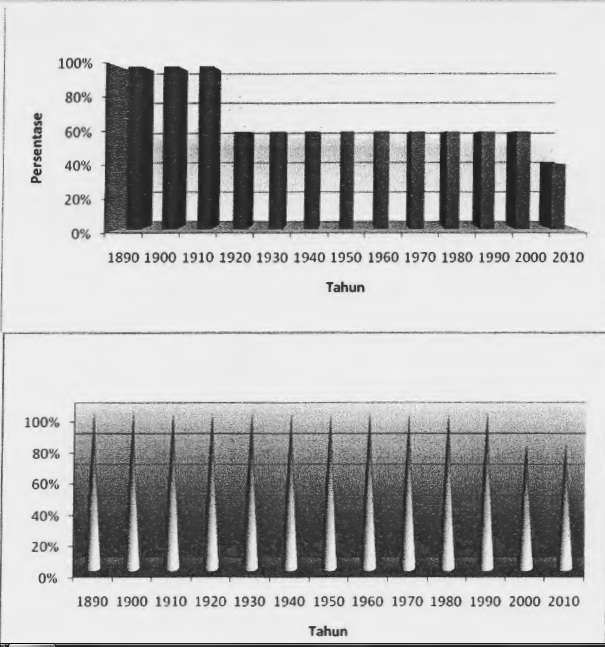
D'après le nombre de la population des espèces de crustacés, dans les espèces les plus communes des bassins versants Ciliwung de crevettes Macrobrachium genre, alors que dans le bassin versant Cisadane espèces les plus communes de la crevette du genre Caridina. Toutefois, en termes de nombre d'individus, crevettes Macrobrachium lanchesteri est plus promient sur upperstream à l'aval de la rivière. De échantillon prélevé, 57% par rapport à la rivière Ciliwung et 76% par rapport à Cisadane River est Macrobrachium lanchesteri . Caridina cf propinqua ne peut être trouvée sur upperstream à la zone middlestream de la rivière, ils ne peuvent pas être trouvées sur en aval de la rivière qui est estuaires de la mer d'eau salée de la marée. Contrairement à C. cognata et C. gracilipes qui se trouve sur la zone en aval de la rivière. Macrobrachium pilimanus aime fort courant d'eau dont certains terrains grosse pierre. M. sintangense se trouve généralement dans lent actuel du lac ou un petit pas de courant . crabes, des Malayopotamon Javanense Parathelphusa bogorensis et Geosesarma sp. se trouvent dans les hautes terres. Surtout M. javanense et P. bogorensis sont des résidents de la rivière au courant rapide. Comme avec le sp Geosesarma. contenue dans un sol humide fosse. P. convexa a une large diffusion; des rizières et les fossés où l'eau est stagnante ou lente région en amont de la hauteur des gouttières et de petits lacs dans les basses terres.
M lanchesteri dan Cherax quadricarinatus sont introduits à partir des activités de pêche. Alors que M. lanchesteri (Native sud de la Thaïlande) pénètrent accidentellement dans le système aquatique et Cherax quadricarinatus (Australie natale) est le dessein de la tenue d'ornement et peut également être vendu comme aliment. Cette espèce envahissante provoque des espèces indigènes comme M sintangense pour déplacer vers l'aval car, contrairement à M lanchesteri, M. sintangense ne peut pas se température plus élevée due à la déforestation autour du lit de la rivière. Étant donné qu'entre 1990 et 2000, M lanchesteri se trouve dans les eaux Ciliwung. Entre 2000 et 2010 C. quadricarinatus est cultivé dans les petites lac Sawangan avec d'autres poissons d'ornement. Sawangan et Pengasingan, Depok sont le lieu le plus approprié pour cultiver des poissons et des crevettes pour la culture de poissons d'ornement et de la crevette parce qu'ils seront facilement le transport et vendu à Jakarta. Un peu différent de celui du petit lac à partir du flux Cisadane qui est dans les villages sont relativement pas si facile à transporter et parce que les accès ne sont pas si bon. Par conséquent, les gens préfèrent cultiver la consommation de poisson, et M lanchesteri va dans les eaux publiques avec les espèces de poissons consumtive.
Ce graphique montre une perte en pourcentage/année de crustacés Ciliwung rivière (ci-dessus) et Cisadane rivière (ci-dessous)

Reference:
1. Aristocratama - http://aristocratama.com/gallery/main_files/shrimp5a.html
2. Aquariumphoto - http://www.aquariumphoto.dk/crustaceans/macrobrachium_pilimanus.htm
3. EOL - http://eol.org/pages/1022076/entries/34263280/overview
4. AquariaCentral - http://www.aquariacentral.com/forums/showthread.php?186648-macrobrachium-lanchesteri-%28guaging-interest%29
5. GarfishIndo - http://www.garfishindo.com/lobster.html
6. IUCN - http://www.iucnredlist.org/apps/redlist/details/134139/0/full
7. Forum Panzerwelten - http://www.panzerwelten.de/forum/thread-2172-page-3.html
8. Fobi - http://www.fobi.web.id/key/Crustacea?g2_itemId=25565
9. athome's 89sky.net - http://89sky.net/vbb/blog.php?b=462
10. Caridea.de - http://www.caridea.de/php/artenliste/artenid.php?artid=64
11. Differences in susceptibility of palaemonid shrimp species to yellow head virus (YHV) infection (Siwaporn Longyant et al)
Glossary:
* Sunda is a region in West java & Banten Province, so West Java and Banten Province is synonim with Sunda..
--------
Glossaire
* Sonde est une région dans l'ouest de Java et la province de Banten, Java-Ouest et si la province de Banten est synonim avec Sonde ..
2.1 Crustacea
Four species of shrimps had been found from Ciliwung River: Caridina cf propinqua, Macrobrachium pilimanus, M sintangense dan M lanchesteri
---------------
Quatre espèces de crevettes ont été trouvés à partir de de la rivière Ciliwung: Caridina cf propinqua, Macrobrachium pilimanus, M sintangense dan M lanchesteri
- Spoiler:
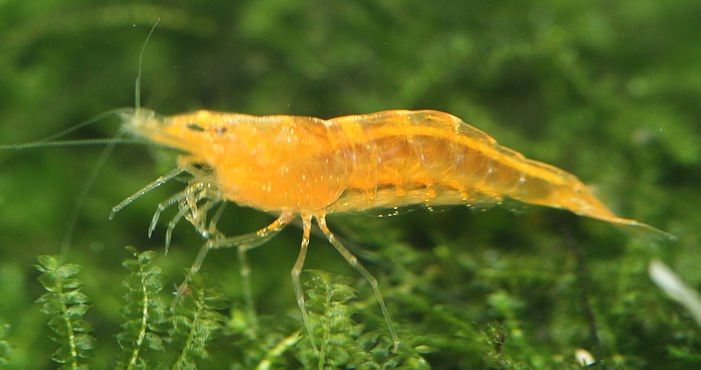
Caridina cf. propinqua taken from // prélevé aristocratama.com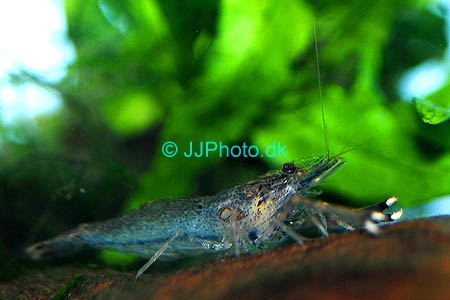
Macrobrachium pilimanus / Chameleon shrimp taken from // Crevettes Chameleon prise de aquariumphoto.dk [2]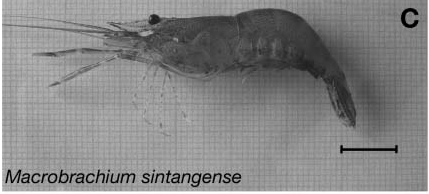
Macrobrachium sintangense / Sunda* River Prawn / Sonde rivière de crevettes[3].. Sorry, can't find a better picture, I got this one from the specimen that infected with YPV.. // Désolé, ne peut pas trouver une meilleure image, je me suis celui de l'échantillon qui a infecté avec YPV .. [11]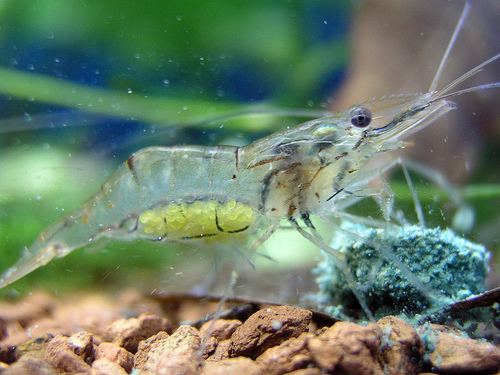
Macrobrachium lanchesteri / Rice Field Prawn taken from // Champ de riz aux crevettes prises à partir AquariaCentral [4]
One species of Lobster: Cherax quadricarinatus
---------------
Une espèce de homard: Cherax quadricarinatus
- Spoiler:

Cherax quadricarinatus / Blue Crayfish taken from GarfishIndo[5]
Four Species of Crabs: Malayopotamon javanense, Parathelphusa bogorensis, P. convexa, Geosesarma sp
---------------
Quatre espèces de crabes: Malayopotamon javanense, Parathelphusa bogorensis, P. convexa, Geosesarma sp
- Spoiler:
Malayopotamon javanense - Insufficient data / Les données sont insuffisantes [6]
Parathelphusa bogorensis taken from // prélevé Panzerwelten.de Forum.. It seems like this is the specimen.. // Il semble que ce n'est le spécimen .. [7]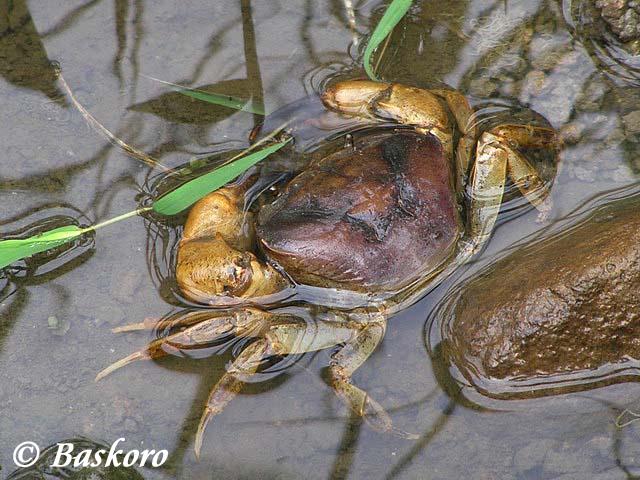
Parathelphusa convexa taken from // prélevé fobi.web.id (copyrighted by Baskoro), the description says that this specimen was taken from Semarang (Capital City of Central Java Province) // la description dit que ce spécimen a été pris de Semarang (capitale de la province centrale de Java)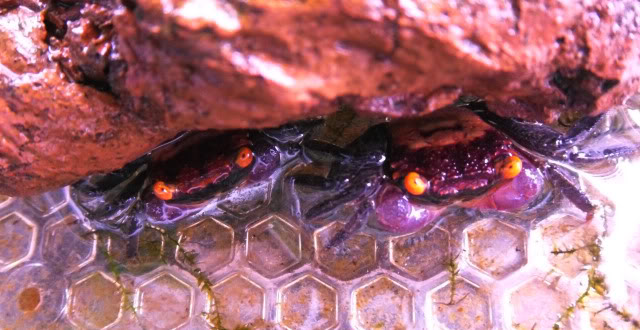
Geosesarma sp. - Tyrano34's photo of the species.. Can't be sure if this is the right specimen from the river.. // Tyrano34 photo de l'espèce .. Ne peut pas être sûr si cela est le spécimen le droit de la rivière ..
Four species of shrimps had been found from Cisadane River: Caridina cognata, C. gracilipes, C. cf propinqua, Macrobrachium lanchesteri dan M sintangense
-------------
Quatre espèces de crevettes ont été trouvés à partir de Cisadane rivière: Caridina cognata, C. gracilipes, C. cf propinqua, Macrobrachium lanchesteri dan M sintangense
- Spoiler:

Caridina cognata / taken from // prélevé Caridea.de [10]
Caridina gracilipes / Rice Shrimp, taken from // Crevettes Riz, prises à partir athome's 89sky.net [9]
Caridina cf. propinqua taken from // prélevé aristocratama.com
Macrobrachium lanchesteri / Rice Field Prawn taken from // Champ de riz aux crevettes prises à partir AquariaCentral [4]
Macrobrachium sintangense / Sunda* River Prawn / Sonde rivière de crevettes[3].. Sorry, can't find a better picture, I got this one from the specimen that infected with YPV.. // Désolé, ne peut pas trouver une meilleure image, je me suis celui de l'échantillon qui a infecté avec YPV .. [11]
One Species of Crabs: Parathelphusa convexa
-------------
Une espèce de crabes
- Spoiler:

Parathelphusa convexa taken from // prélevé fobi.web.id (copyrighted by Baskoro), the description says that this specimen was taken from Semarang (Capital City of Central Java Province) // la description dit que ce spécimen a été pris de Semarang (capitale de la province centrale de Java)
From the population number of species of crustaceans, in the watershed Ciliwung most common species of shrimp Macrobrachium genus, whereas in the watershed Cisadane most common species of shrimp genus Caridina. However, in terms of number of individuals, prawn Macrobrachium lanchesteri is more promient on upperstream to downstream of the river. From sample taken, 57% from Ciliwung River and 76% from Cisadane River is Macrobrachium lanchesteri. Caridina cf propinqua can only be found on upperstream to middlestream area of the river, they can't be found on downstream of the river which is estuaries of saltwater tidal sea. Unlike C. cognata and C. gracilipes which can be found on downstream area of the river. Macrobrachium pilimanus likes strong current water which some large stone terrain. M. sintangense is usually found in slow moving current or small lake with no current. Javanense Malayopotamon crabs, Parathelphusa bogorensis, and Geosesarma sp. are found in the uplands. Especially M. javanense and P. bogorensis are residents of fast-flowing river. As with the Geosesarma sp. contained in a pit moist soil. P. convexa has broad dissemination; of rice fields and ditches where the water is stagnant or slow-moving upstream region from up to the gutters and small lakes in the lowlands.
M lanchesteri dan Cherax quadricarinatus are introduced from fishery activities. While M. lanchesteri (Native Southern Thailand) accidentally enter the watery system and Cherax quadricarinatus (native Australia)is purposed for ornamental keeping and can also be sold as food. This invasive species will cause the native species like M sintangense to move to downstream because unlike M lanchesteri, M. sintangense can't stand higher temperature due to deforestation around the riverbed. Since between 1990 and 2000, M lanchesteri is found in Ciliwung waters. Between 2000 and 2010 C. quadricarinatus is cultivated in Small lake Sawangan together with other ornamental fish. Sawangan and Pengasingan, Depok are the more suitable place to cultivate fish and shrimp for the cultivation of ornamental fish and shrimp because they will be easily transport and sold to Jakarta. Somewhat different from that of the small lake from Cisadane stream that is in the villages are relatively not so easy to transport and because the access are not so good. Therefore, people prefer to cultivate fish consumption, and M lanchesteri goes in public waters with consumtive fish species.
This graphic shows a percentage/year crustacea loss in Ciliwung River (above) and Cisadane River (Below)

D'après le nombre de la population des espèces de crustacés, dans les espèces les plus communes des bassins versants Ciliwung de crevettes Macrobrachium genre, alors que dans le bassin versant Cisadane espèces les plus communes de la crevette du genre Caridina. Toutefois, en termes de nombre d'individus, crevettes Macrobrachium lanchesteri est plus promient sur upperstream à l'aval de la rivière. De échantillon prélevé, 57% par rapport à la rivière Ciliwung et 76% par rapport à Cisadane River est Macrobrachium lanchesteri . Caridina cf propinqua ne peut être trouvée sur upperstream à la zone middlestream de la rivière, ils ne peuvent pas être trouvées sur en aval de la rivière qui est estuaires de la mer d'eau salée de la marée. Contrairement à C. cognata et C. gracilipes qui se trouve sur la zone en aval de la rivière. Macrobrachium pilimanus aime fort courant d'eau dont certains terrains grosse pierre. M. sintangense se trouve généralement dans lent actuel du lac ou un petit pas de courant . crabes, des Malayopotamon Javanense Parathelphusa bogorensis et Geosesarma sp. se trouvent dans les hautes terres. Surtout M. javanense et P. bogorensis sont des résidents de la rivière au courant rapide. Comme avec le sp Geosesarma. contenue dans un sol humide fosse. P. convexa a une large diffusion; des rizières et les fossés où l'eau est stagnante ou lente région en amont de la hauteur des gouttières et de petits lacs dans les basses terres.
M lanchesteri dan Cherax quadricarinatus sont introduits à partir des activités de pêche. Alors que M. lanchesteri (Native sud de la Thaïlande) pénètrent accidentellement dans le système aquatique et Cherax quadricarinatus (Australie natale) est le dessein de la tenue d'ornement et peut également être vendu comme aliment. Cette espèce envahissante provoque des espèces indigènes comme M sintangense pour déplacer vers l'aval car, contrairement à M lanchesteri, M. sintangense ne peut pas se température plus élevée due à la déforestation autour du lit de la rivière. Étant donné qu'entre 1990 et 2000, M lanchesteri se trouve dans les eaux Ciliwung. Entre 2000 et 2010 C. quadricarinatus est cultivé dans les petites lac Sawangan avec d'autres poissons d'ornement. Sawangan et Pengasingan, Depok sont le lieu le plus approprié pour cultiver des poissons et des crevettes pour la culture de poissons d'ornement et de la crevette parce qu'ils seront facilement le transport et vendu à Jakarta. Un peu différent de celui du petit lac à partir du flux Cisadane qui est dans les villages sont relativement pas si facile à transporter et parce que les accès ne sont pas si bon. Par conséquent, les gens préfèrent cultiver la consommation de poisson, et M lanchesteri va dans les eaux publiques avec les espèces de poissons consumtive.
Ce graphique montre une perte en pourcentage/année de crustacés Ciliwung rivière (ci-dessus) et Cisadane rivière (ci-dessous)

Reference:
1. Aristocratama - http://aristocratama.com/gallery/main_files/shrimp5a.html
2. Aquariumphoto - http://www.aquariumphoto.dk/crustaceans/macrobrachium_pilimanus.htm
3. EOL - http://eol.org/pages/1022076/entries/34263280/overview
4. AquariaCentral - http://www.aquariacentral.com/forums/showthread.php?186648-macrobrachium-lanchesteri-%28guaging-interest%29
5. GarfishIndo - http://www.garfishindo.com/lobster.html
6. IUCN - http://www.iucnredlist.org/apps/redlist/details/134139/0/full
7. Forum Panzerwelten - http://www.panzerwelten.de/forum/thread-2172-page-3.html
8. Fobi - http://www.fobi.web.id/key/Crustacea?g2_itemId=25565
9. athome's 89sky.net - http://89sky.net/vbb/blog.php?b=462
10. Caridea.de - http://www.caridea.de/php/artenliste/artenid.php?artid=64
11. Differences in susceptibility of palaemonid shrimp species to yellow head virus (YHV) infection (Siwaporn Longyant et al)
Glossary:
* Sunda is a region in West java & Banten Province, so West Java and Banten Province is synonim with Sunda..
--------
Glossaire
* Sonde est une région dans l'ouest de Java et la province de Banten, Java-Ouest et si la province de Banten est synonim avec Sonde ..
 Fish / Poissons
Fish / Poissons
2012-03-11, 10:13 pm
2.2 Fish / Poissons
2.2.1There are 23 species of fish found in Ciliwung River, most of them are found in downstream area of the river.
18 of them are native fish of Ciliwung River: Notopterus notopterus, Chanos chanos, Cyclocheilichthys cf apogon, Osteochilus hasselti, Puntius binotatus, Rasbora lateristriata, Nemacheilus chrysolaimos, Glyptothorax platypogon, Dermogenys pusilla, Aplocheilus panchax, Ambassis sp., Oxyleotris marmorata, Mugilogobius sp, Trichogaster trichopterus, Trichopsis vittata, Channa gachua, Macrognathus maculatus, and Cyprinus carpio
------------
Il ya 23 espèces de poissons trouvés dans Ciliwung rivière, la plupart d'entre eux se trouvent dans la zone en aval de la rivière.
18 d'entre eux sont des poissons indigènes de la rivière Ciliwung: Notopterus notopterus, Chanos chanos, Cyclocheilichthys cf apogon, Osteochilus hasselti, Puntius binotatus, Rasbora lateristriata, Nemacheilus chrysolaimos, Glyptothorax platypogon, Dermogenys pusilla, Aplocheilus panchax, Ambassis sp., Oxyleotris marmorata, Mugilogobius sp, Trichogaster trichopterus, Trichopsis vittata, Channa gachua, Macrognathus maculatus, Cyprinus carpio
And 5 of them are invasive species: Cyprinus carpio, Pterygoplichthys pardalis, Oreochromis cf niloticus, Oreochromis mossambicus, Collossoma macropomum, and Poecillia reticulata
------------
Et 5 d'entre eux sont des espèces envahissantes: Pterygoplichthys pardalis, Oreochromis cf niloticus, Oreochromis mossambicus, Collossoma macropomum, and Poecillia reticulata
********************
2.2.2There are 31 species of fish found in Cisadane River, most of them are found in downstream area of the river.
24 of them are native fish of Ciliwung River: Barbonymus gonionotus, Cyclocheilichthys apogon, Osteochilus sp, Parachela sp, Puntius binotatus, Puntius tetrazona, Rasbora sp., Rasbora sp. 1, Kottelatlimia cf pristes, Clarias sp., Ompok bimaculatus, Dermogenys pusilla, Oryzias javanicus, Aplocheilus panchax, Monopterus albus, Ambassis sp., Oxyleotris marmorata, Glosogobius giuris, Brachygobius aggregatus, Osphronemus goramy, Anabas testudineus, Trichogaster trichopterus, Trichopsis vittata, Channa striata
------------
Il ya 31 espèces de poissons trouvés dans Cisadane rivière, la plupart d'entre eux se trouvent dans la zone en aval de la rivière.
24 d'entre eux sont des poissons indigènes de la rivière Ciliwung: Barbonymus gonionotus, Cyclocheilichthys apogon, Osteochilus sp, Parachela sp, Puntius binotatus, Puntius tetrazona, Rasbora sp., Rasbora sp. 1, Kottelatlimia cf pristes, Clarias sp., Ompok bimaculatus, Dermogenys pusilla, Oryzias javanicus, Aplocheilus panchax, Monopterus albus, Ambassis sp., Oxyleotris marmorata, Glosogobius giuris, Brachygobius aggregatus, Osphronemus goramy, Anabas testudineus, Trichogaster trichopterus, Trichopsis vittata, Channa striata
And 7 of them are invasive species: Esomus cf metallicus, Pterygoplichthys pardalis, Poecillia reticulata, Xiphophorus hellerii, Oreochromis niloticus, Amphilophus labiatus, Pterophyllum scalare
------------
Et 7 d'entre eux sont des espèces envahissantes: Esomus cf metallicus, Pterygoplichthys pardalis, Poecillia reticulata, Xiphophorus hellerii, Oreochromis niloticus, Amphilophus labiatus, Pterophyllum scalare
*************************
2.2.3 - A Study on Estimated Loss of Bio-Diversity - Fish
Ciliwung River
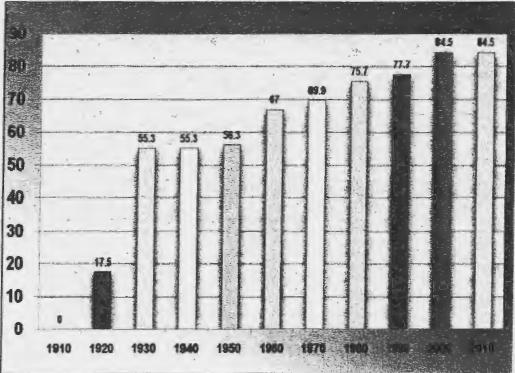
According to several literatures (Weber & de Beaufort, 1913, 1916, 1921, 1922, 1929, 1931, 1936; Koumans, 1953), it was known that 187 species of fish lived in Ciliwung River area during 1910s. However, in 2009 only 187 species of fish were recorded and 5 among them were alien fish. This research uncovers 23 species of fish, with 6 among them are alien .
Not all of these fish are freshwater fish, so after some categorising, 103 species of fish caught are categorised as freshwater species. This table shows that in 2010, there's a loss of 84.5% of fish species in Ciliwung River area. This number is less than that of river area, which has 92.5% loss.
According to a specimen study, it is discovered that one alien fish species was first observed in general waters in 1970. In 1990, this number rose to 5. And in 2010, 6 alien species are observed in general waters.
-----
Selon plusieurs littératures (Weber & de Beaufort, 1913, 1916, 1921, 1922, 1929, 1931, 1936; Koumans, 1953), il était connu que 187 espèces de poissons vivent dans Ciliwung région de la rivière au cours années 1910. Cependant, en 2009 seulement 187 espèces de poissons ont été enregistrés et 5 d'entre eux étaient des poissons exotiques. Cette recherche révèle 23 espèces de poissons, avec 6 d'entre eux sont étrangers.
Pas tous ces poissons sont des poissons d'eau douce, donc après un certain classement, 103 espèces de poissons capturés sont classés comme espèces d'eau douce. Ce tableau montre qu'en 2010, il ya une perte de 84,5% des espèces de poissons dans Ciliwung région de la rivière. Ce nombre est inférieur à celui de la zone rivière, qui présente une perte 92,5%.
Selon une étude exemplaire, il est découvert qu'une espèce de poissons exotiques a d'abord été observée dans les eaux générales en 1970. En 1990, ce nombre a augmenté à 5. Et en 2010, 6 espèces exotiques sont observées dans les eaux générales.
Cisadane River

According to literature studies, there were 135 species of fish that lived in Cisadane River area in the 1910s. However, in 2009 only 33 native fish species were recorded, 6 of them were alien fish species. In 2010, 31 native fish species were found, 7 of them were alien. This research shows that 74.4% of fish species are lost in Cisadane pond areas, a bit fewer than the loss in the river area, which is 75.6%.
--------
Selon des études de littérature, il y avait 135 espèces de poissons qui vivaient dans la région du fleuve Cisadane dans les années 1910. Cependant, en 2009 seulement 33 espèces de poissons indigènes ont été enregistrés, 6 d'entre eux étaient des espèces de poissons exotiques. En 2010, 31 espèces de poissons indigènes ont été trouvés, 7 d'entre eux étaient étrangers. Cette recherche montre que 74,4% des espèces de poissons sont perdues dans les zones d'étang Cisadane, un peu moins que la perte dans la région de la rivière, ce qui est de 75,6%.
********
There is a quite delightful result from the research done in ponds within Ciliwung river area. During the research, we managed to discover fish species that couldn't be obtained from the river nor its streams such as the Clown Featherback fish, Notopterus notopterus. This type of fish has been gone from Indonesian rivers hence it is a protected species. Another native fish species that was found was Marbled Sleeper Goby, Oxyeleotris marmorata.
As with all good news, there is also some bad news. This research discovered that Collossoma cf macropomus or Black Body Pacu was found in the river. This kind of fish is a family of Piranha (Serrasalmus spp), which is illegal to enter Indonesian waters. Even though this species isn't as dangerous as its family, its very existence has disturbed the native bio diversity of the pond.
One of the reasons why there are many alien fish species in the region is because there have been events of spreading fish fry into the river, both by a governmental and non-governmental agencies, in an effort to save the river. However, they don't spread native fish species, but alien species such as Nile Tilapia (Oreochromis nicolatus), Common carp (Cyprinus carpio), and Mozzambiq Tilapia (Oreochromis mossambiqus). And other fish such as Esomus cf. metallicus and Amphilophus citrinellus are spreading water system from ornamental fishkeeping..
For example, in May 2010, there was an event in Cilalay small lake, where the commitees decided to spread nile tilapia into the river. This is certainly an alien species to this pond hence the team had been adviced them to spread Pearl Gourami (Trichogaster leeri) which had been lost althought it was the native species of the river..
---------
[color=orange] Il ya un résultat tout à fait délicieux de la recherche effectuée dans les étangs au sein de Ciliwung région de la rivière. Au cours de la recherche, nous avons réussi à découvrir des espèces de poissons qui n'ont pas pu être obtenus à partir de la rivière, ni ses cours d'eau tels que le poisson clown featherback, Notopterus notopterus . Ce type de poisson a été passé de rivières indonésiennes par conséquent, il est une espèce protégée. Une autre espèce de poissons indigènes qui ont été trouvés a été Goby Sleeper marbrée, Oxyeleotris marmorata .
Comme avec toutes les bonnes nouvelles, il ya aussi quelques mauvaises nouvelles. Cette recherche a découvert que Collossoma cf macropomus ou corps noir Pacu a été trouvé dans la rivière. Ce genre de poisson est une famille de Piranha ( Serrasalmus spp ), ce qui est illégal d'entrer dans les eaux indonésiennes. Même si cette espèce n'est pas aussi dangereux que sa famille, son existence même a perturbé la diversité bio natif de l'étang.
Une des raisons pour lesquelles il existe de nombreuses espèces de poissons exotiques dans la région est parce qu'il ya eu des événements de propagation alevins dans la rivière, à la fois par quelques agences gouvernementales et non gouvernementales, dans un effort pour sauver la rivière. Cependant, ils n'ont pas la propagation d'espèces de poissons indigènes, mais les espèces exotiques telles que le tilapia du Nil ( Oreochromis nicolatus ), la carpe commune ( Cyprinus carpio ), et Mozzambiq Tilapia ( Oreochromis mossambiqus ). Et d'autres poissons tels que cf Esomus. metallicus et Amphilophus citrinellus se répandent système d'eau de l'aquariophilie ornementale ..
Par exemple, en mai 2010, il y avait un événement dans Cilalay petit lac, où les comités de décidé d'étendre le tilapia du Nil dans la rivière. Ce n'est certainement une espèce exotique à cet étang où l'équipe avait été averti à répandre Perle Gourami ( Trichogaster leeri ) qui avait été perdu Althought ce sont les espèces indigènes de la rivière ..
******************
Reference:
1. Boldsystems - http://www.boldsystems.org/views/taxbrowser.php?taxid=1144
2. Aquatoyou - http://www.aquatoyou.com/index.php/en/component/content/article/38-2010-01-09-02-26-45/squid/332-2010-02-27-13-14-54
3. aquariumphoto - http://www.aquariumphoto.dk/puntius_binotatus.htm
4. Planet Catfish - http://www.planetcatfish.com/catelog/image.php?species=glyptothorax+platypogon&image_id=6970
5. Fishbase - http://www.fishbase.us/Photos/PicturesSummary.php?ID=4756&what=species
6. Dingo Spike's post Istorya Forum - http://www.istorya.net/forums/pet-discussions/134681-aquatic-cebu-enthusiasts-ace-1803.html
7. Animal Earth - http://animal-earth.com/forum/index.php?showtopic=165
8. Habitat News - http://habitatnews.nus.edu.sg/guidebooks/freshfish/text/228.htm
9. Loaches.com - http://www.loaches.com/species-index/kottelatlimia-pristes
10. Planet Catfish - http://www.planetcatfish.com/catelog/image.php?species=ompok+bimaculatus&image_id=2021
11. Fishbase - http://www.fishbase.us/summary/Glossogobius-giuris.html
12. Mazapura - http://mazapura.com/shop/gobiidae/2478--.html
13. Fishbase - http://www.fishbase.us/summary/Channa-striata.html
2.2.1There are 23 species of fish found in Ciliwung River, most of them are found in downstream area of the river.
18 of them are native fish of Ciliwung River: Notopterus notopterus, Chanos chanos, Cyclocheilichthys cf apogon, Osteochilus hasselti, Puntius binotatus, Rasbora lateristriata, Nemacheilus chrysolaimos, Glyptothorax platypogon, Dermogenys pusilla, Aplocheilus panchax, Ambassis sp., Oxyleotris marmorata, Mugilogobius sp, Trichogaster trichopterus, Trichopsis vittata, Channa gachua, Macrognathus maculatus, and Cyprinus carpio
------------
Il ya 23 espèces de poissons trouvés dans Ciliwung rivière, la plupart d'entre eux se trouvent dans la zone en aval de la rivière.
18 d'entre eux sont des poissons indigènes de la rivière Ciliwung: Notopterus notopterus, Chanos chanos, Cyclocheilichthys cf apogon, Osteochilus hasselti, Puntius binotatus, Rasbora lateristriata, Nemacheilus chrysolaimos, Glyptothorax platypogon, Dermogenys pusilla, Aplocheilus panchax, Ambassis sp., Oxyleotris marmorata, Mugilogobius sp, Trichogaster trichopterus, Trichopsis vittata, Channa gachua, Macrognathus maculatus, Cyprinus carpio
- Spoiler:
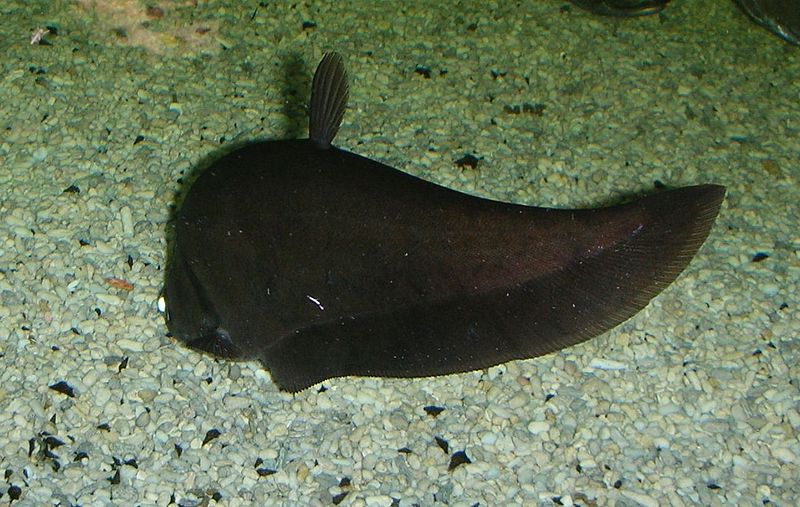
Notopterus notopterus; Bronze Featherback; Local Common Names // Nom local commun: Belida
This fish usually becomes food comsumption, like crispy cracker from Palembang, South Sumatera Province, Sumatera
Ce poisson devient généralement la consommation d'aliments, comme pirate croustillant de Palembang, Sumatra du Sud Province, Sumatra
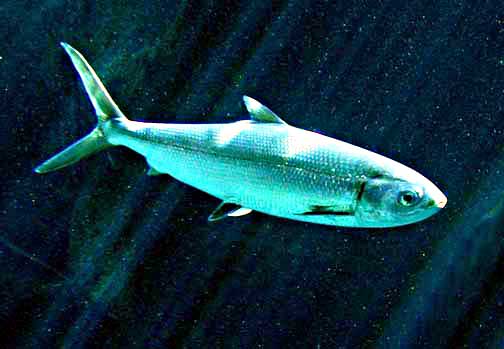
Chanos chanos; Milkfish; Local Common Names // Nom local commun: Bandeng
This fish usually becomes food comsumption, quite hard to eat this fish due to it's bone scattered everywhere. So people usually prefer to eat a softened boned Bandeng.
Ce poisson devient généralement comsumption nourriture, assez difficile de manger ce poisson en raison de son os éparpillés un peu partout. Alors, les gens préfèrent généralement de manger un Bandeng adoucie désossée.
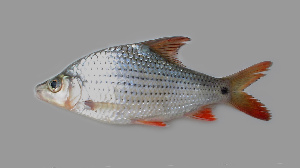
Cyclocheilichthys cf apogon; Beardless Barb; Local Common Names // Nom local commun: Seren
Picture was taken from boldsystems [ 1 ], can't find a cf (similar) because it should be a javanese varian, while this species range in South East Asia.
Photo a été prise à partir boldsystems [ 1 ], ne peut pas trouver un cf (similaire), car il devrait y avoir un Varian javanais, alors que cette aire de répartition en Asie du Sud.
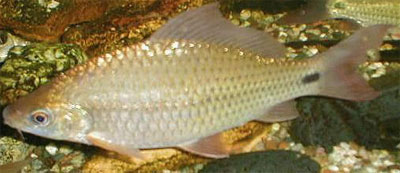
Osteochilus hasselti; Hard-Lipped Barb; Local Common Names // Nom local commun: Nilem
This fish is also a consumptive fish; Picture taken from Aquatoyou [ 2 ]
Ce poisson est aussi un poisson de consommation; Photo prise à partir Aquatoyou [ 2 ]
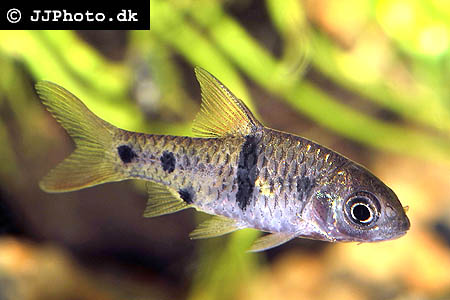
Puntius binotatus; Spotted Barb; Local Common Names // Nom local commun: Banteur / Wader
Picture was taken from aquariumphoto.dk [ 3 ]
Photo a été prise à partir aquariumphoto.dk [ 3 ]
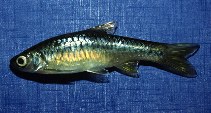
Rasbora lateristriata; Yellow Rasbora; Local Common Names // Nom local commun: Paray / Seluang
Picture was taken from Fishbase
Photo a été prise à partir de Fishbase

Nemacheilus chrysolaimos; Local Common Names // Nom local commun: Jeler

Glyptothorax platypogon; Local Common Names // Nom local commun: Kehkel
Picture was taken from planet catfish [ 4 ]
Photo a été prise à partir de poissons-chats planète [ 4 ]
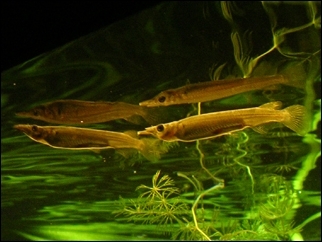
Dermogenys pusilla; Wrestling Half-Beak; Local Common Names // Nom local commun: Julung Julung
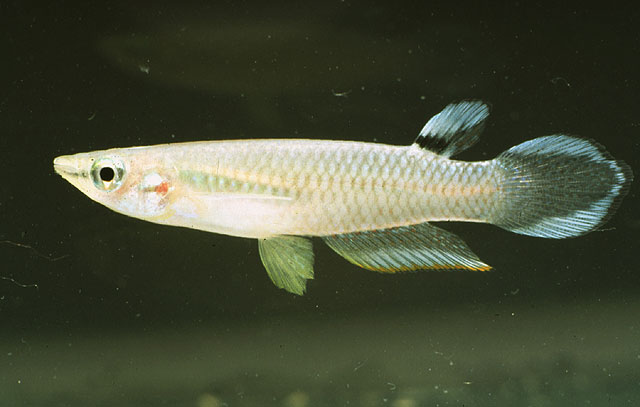
Aplocheilus panchax; Whitespot; Local Common Names // Nom local commun: Kepala Timah (Literaly: Tin Head)
Picture was taken from fishbase [ 5 ]
Photo a été prise à partir de FishBase [5]

Ambassis sp.; Glass Fish; Local Common Names // Nom local commun: Ikan Kaca (Literaly: Glass Fish)
Picture was taken from Dingo Spike's post on Istorya Forum [ 6 ], This picture is described as Ambassis interrupta, so of course the specimen would be different from what it's described from Daisy Wowor's publication.
Photo a été prise de poste Dingo Spike sur Istorya Forum [ 6 ], Cette photo est décrite comme Ambassis interrupta , donc bien sûr le spécimen serait différente de ce qu'elle est décrite à partir de la publication de Daisy Wowor.
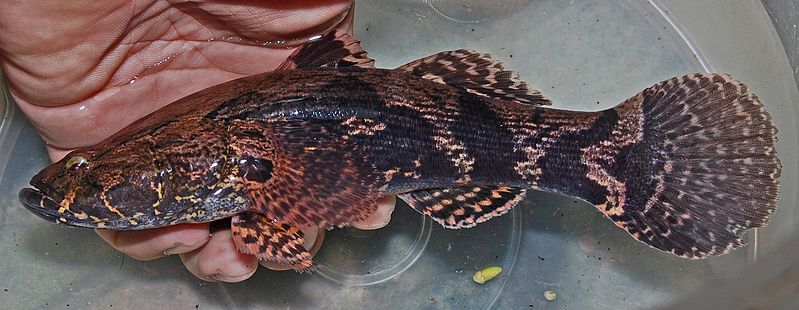
Oxyleotris marmorata; Marbled Sleeper; Local Common Names // Nom local commun: Betutu
- Mugilogobius sp
Can't find a more describing photo due to not being described species.
Vous ne trouvez pas une photo plus décrivant raison de ne pas être décrit espèces.

Trichogaster trichopterus; Three Spot Gourami; Local Common Names // Nom local commun: Sepat
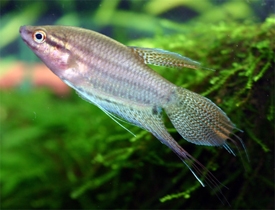
Trichopsis vittata; Croacking Gourami; Local Common Names // Nom local commun: Cupang (Betta common name)
Picture was taken from Animal Earth [ 7 ]
Photo a été prise depuis Animal Earth [ 7 ]
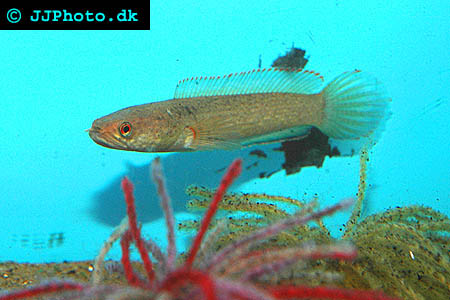
Channa gachua; Dwarf Snakehead; Local Common Names // Nom local commun: Gabus
Picture is copyrighted by JJphoto

Macrognathus maculatus; Buff-backed Spiny Eel; Local Common Names // Nom local commun: Arelot
Picture was taken from HabitatNews [ 8 ]
Photo a été prise à partir HabitatNews [ 8 ]
Cyprinus carpio; Common Carp; Local Common Names // Nom local commun: Mas (Literaly: Gold)
Considered to be one of the most consumptive fish in Indonesia
Considéré comme l'un des poissons les plus consommatrices en Indonésie
And 5 of them are invasive species: Cyprinus carpio, Pterygoplichthys pardalis, Oreochromis cf niloticus, Oreochromis mossambicus, Collossoma macropomum, and Poecillia reticulata
------------
Et 5 d'entre eux sont des espèces envahissantes: Pterygoplichthys pardalis, Oreochromis cf niloticus, Oreochromis mossambicus, Collossoma macropomum, and Poecillia reticulata
- Spoiler:
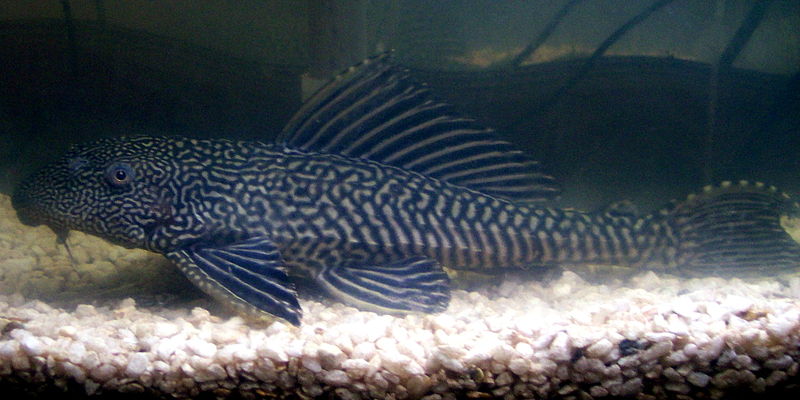
Pterygoplichthys pardalis; Common Pleco; Local Common Names // Nom local commun: Sapu-sapu (Literaly: Broom)
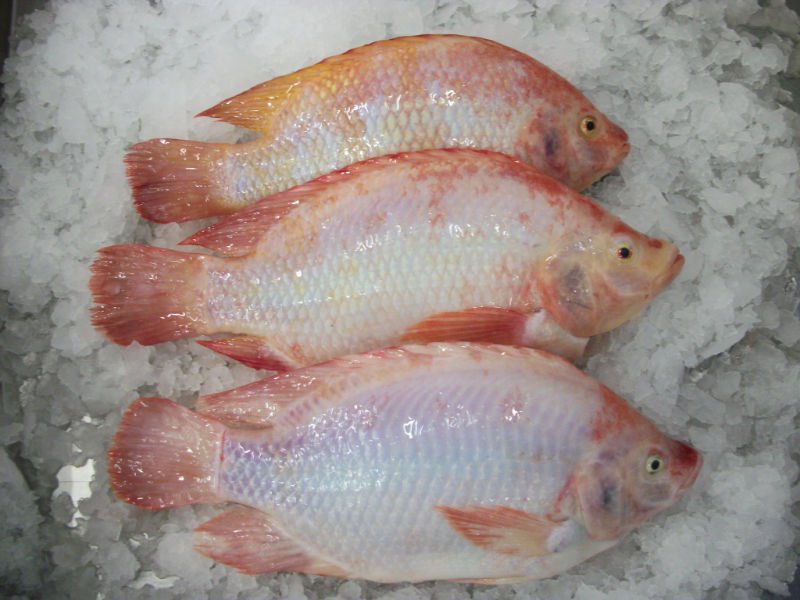
Oreochromis cf niloticus; Nile Tilapia; Local Common Names // Nom local commun: Nila
The photo that is shown is not truly an Oreochromis nicolatus, because Nile Tilapia is usually breed with other Oreochromis genera.. So that's where the "cf" comes from..
La photo qui est montré n'est pas vraiment un nicolatus Oreochromis, parce que le tilapia du Nil est généralement la race avec des genres Oreochromis autres .. Donc, c'est là que le "cf" vient de ..
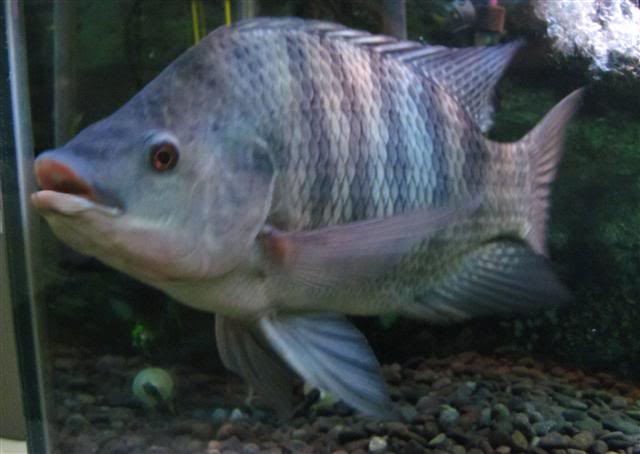
Oreochromis mossambicus; Mozambique Tilapia; Local Common Names // Nom local commun: Mujair

Collossoma macropomum; Black Pacu; Local Common Names // Nom local commun: Bawal Hitam

Poecillia reticulata; Guppy; Local Common Names // Nom local commun: Ikan Seribu (Literaly: A Thousand Fish)
********************
2.2.2There are 31 species of fish found in Cisadane River, most of them are found in downstream area of the river.
24 of them are native fish of Ciliwung River: Barbonymus gonionotus, Cyclocheilichthys apogon, Osteochilus sp, Parachela sp, Puntius binotatus, Puntius tetrazona, Rasbora sp., Rasbora sp. 1, Kottelatlimia cf pristes, Clarias sp., Ompok bimaculatus, Dermogenys pusilla, Oryzias javanicus, Aplocheilus panchax, Monopterus albus, Ambassis sp., Oxyleotris marmorata, Glosogobius giuris, Brachygobius aggregatus, Osphronemus goramy, Anabas testudineus, Trichogaster trichopterus, Trichopsis vittata, Channa striata
------------
Il ya 31 espèces de poissons trouvés dans Cisadane rivière, la plupart d'entre eux se trouvent dans la zone en aval de la rivière.
24 d'entre eux sont des poissons indigènes de la rivière Ciliwung: Barbonymus gonionotus, Cyclocheilichthys apogon, Osteochilus sp, Parachela sp, Puntius binotatus, Puntius tetrazona, Rasbora sp., Rasbora sp. 1, Kottelatlimia cf pristes, Clarias sp., Ompok bimaculatus, Dermogenys pusilla, Oryzias javanicus, Aplocheilus panchax, Monopterus albus, Ambassis sp., Oxyleotris marmorata, Glosogobius giuris, Brachygobius aggregatus, Osphronemus goramy, Anabas testudineus, Trichogaster trichopterus, Trichopsis vittata, Channa striata
- Spoiler:
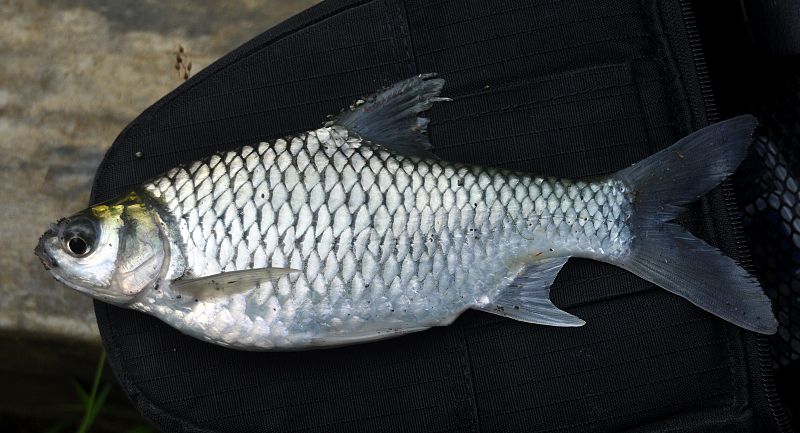
Barbonymus gonionotus; Silver Barb; Local Common Names // Nom local commun: Tawes
This fish usually becomes food comsumption.
Ce poisson devient généralement la consommation d'aliments.

Cyclocheilichthys apogon; Beardless Barb; Local Common Names // Nom local commun: Seren
Picture was taken from boldsystems [ 1 ]
Photo a été prise à partir boldsystems [ 1 ]
Osteochilus sp; Hard-Lipped Barb; Local Common Names // Nom local commun: Nilem
This specimen is not described.. Should be similar to Osteochilus hasselti, look above.
Ce spécimen n'est pas décrit.. Devrait être similaire à Osteochilus hasselti, regardez ci-dessus.
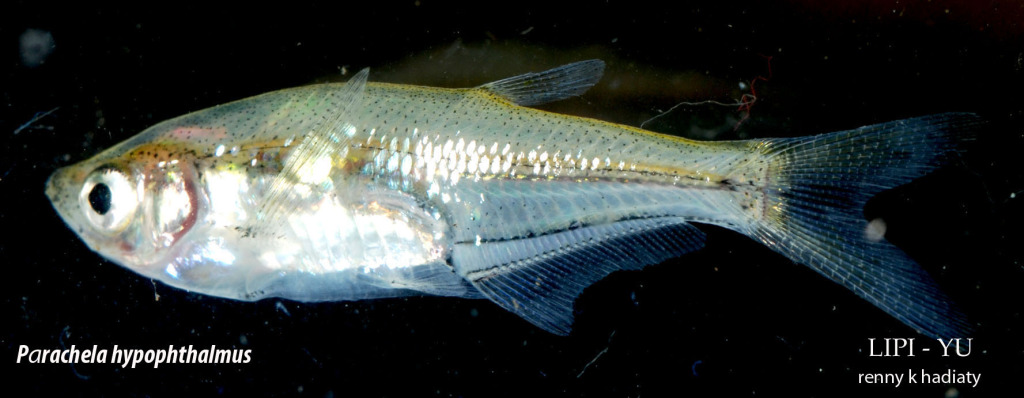
Parachela sp; - ; Local Common Names // Nom local commun: -
Picture is copyrighted by Renny K Hadiaty. The journal isn't describing the species, so I took Parachela hyphothalmus
L'image est protégée par Renny K Hadiaty. La revue n'est pas de décrire les espèces, alors j'ai pris Parachela hyphothalmus

Puntius binotatus; Spotted Barb; Local Common Names // Nom local commun: Banteur / Wader
Picture was taken from aquariumphoto.dk [ 3 ]
Photo a été prise à partir aquariumphoto.dk [ 3 ]
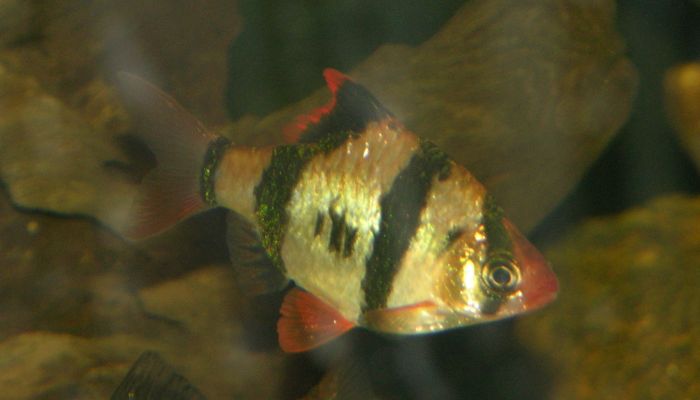
Puntius tetrazona; Sumatera Barb ;Local Common Names // Nom local commun: Ikan Sumatra
Rasbora sp.; Local Common Names // Nom local commun: Paray / Seluang
Undescribed species
espèces non décrites
Rasbora sp. 1; Local Common Names // Nom local commun: Paray / Seluang
Undescribed species
espèces non décrites
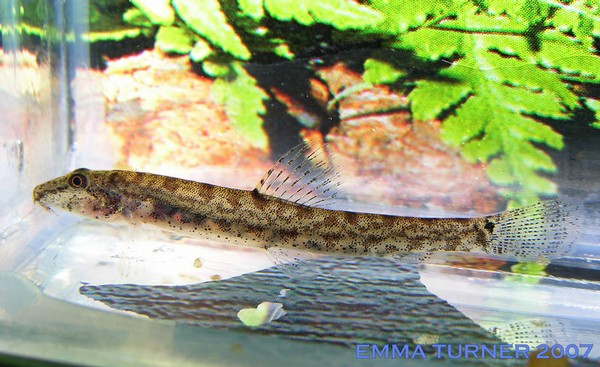
Kottelatlimia cf pristes; Mini Royal Loach; Local Common Names // Nom local commun: -
Picture is copyrighted by Emma Turner from Loaches.com [ 9 ].
L'image est protégée par Emma Turner from Loaches.com [ 9 ].
Clarias sp.; Walking Catfish; Local Common Names // Nom local commun: Lele
Undescribed species
espèces non décrites
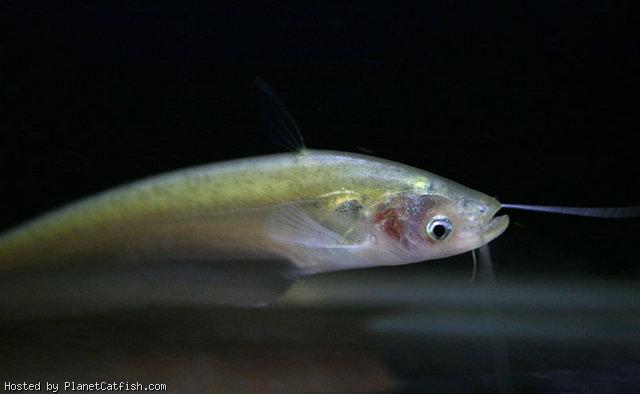
Ompok bimaculatus; Butter Catfish; Local Common Names // Nom local commun: Ompok
Picture is copyrighted by Beta Mahatvaraj from Planetcatfish.com [ 10 ].
L'image est protégée par Beta Mahatvaraj from Planetcatfish.com [ 10 ].

Dermogenys pusilla; Wrestling Half-Beak; Local Common Names // Nom local commun: Julung Julung
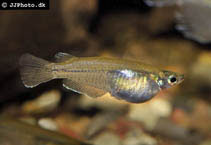
Oryzias javanicus; Javanese Ricefish; Local Common Names // Nom local commun: Ikan padi

Aplocheilus panchax; Whitespot; Local Common Names // Nom local commun: Kepala Timah (Literaly: Tin Head)
Picture was taken from fishbase [ 5 ]
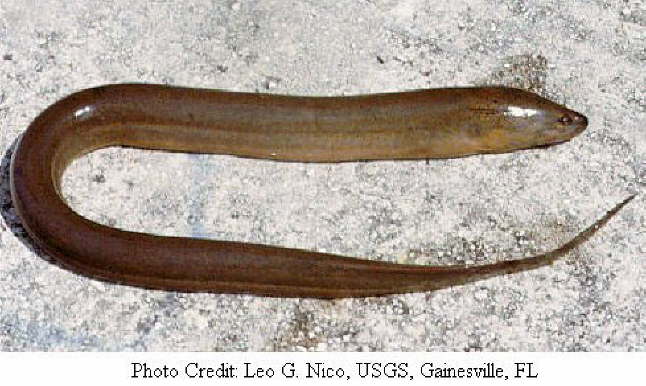
Monopterus albus; Asian Swamp Eel; Local Common Names // Nom local commun: Belut

Ambassis sp.; Glass Fish; Local Common Names // Nom local commun: Ikan Kaca (Literaly: Glass Fish)
Picture was taken from Dingo Spike's post on Istorya Forum [ 6 ], This picture is described as Ambassis interrupta, so of course the specimen would be different from what it's described from Daisy Wowor's publication.

Oxyleotris marmorata; Marbled Sleeper; Local Common Names // Nom local commun: Betutu
Can't find a more describing photo due to not being described species.

Glosogobius giuris; Tank Goby; Local Common Names // Nom local commun: Beloso
Picture was taken from fishbase [ 11 ]
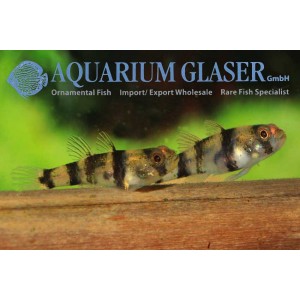
Brachygobius aggregatus; Schooling Bumblebee Goby ; Local Common Names // Nom local commun: Cupang (Betta common name)
Picture was taken from Aquarium Glaser [ 12 ]
Photo a été prise depuis Aquarium Glaser [ 12 ]

Osphronemus goramy; Giant Gourami; Local Common Names // Nom local commun: Gurame
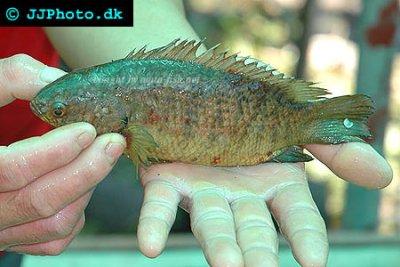
Anabas testudineus; Climbing Perch; Local Common Names // Nom local commun: Betok / Puyu
Picture is copyrighted by JJPhoto
L'image est protégée par JJPhoto

Trichogaster trichopterus; Three Spot Gourami; Local Common Names // Nom local commun: Sepat

Trichopsis vittata; Croacking Gourami; Local Common Names // Nom local commun: Cupang (Betta common name)
Picture was taken from Animal Earth [ 7 ]
Photo a été prise depuis Animal Earth [ 7 ]
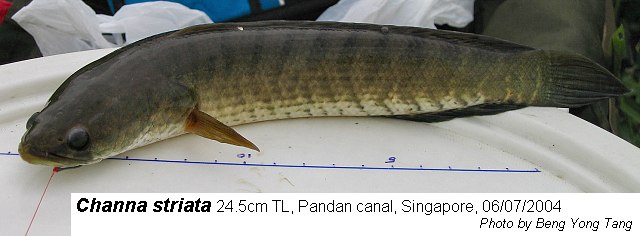
Channa striata; Snakehead Murrel; Local Common Names // Nom local commun: Gabus
Picture was taken from fishbase [13]
And 7 of them are invasive species: Esomus cf metallicus, Pterygoplichthys pardalis, Poecillia reticulata, Xiphophorus hellerii, Oreochromis niloticus, Amphilophus labiatus, Pterophyllum scalare
------------
Et 7 d'entre eux sont des espèces envahissantes: Esomus cf metallicus, Pterygoplichthys pardalis, Poecillia reticulata, Xiphophorus hellerii, Oreochromis niloticus, Amphilophus labiatus, Pterophyllum scalare
- Spoiler:
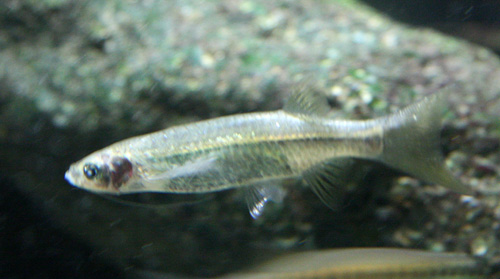
Esomus cf metallicus; Stripped Flying Barb; Local Common Names // Nom local commun: -
Can't find a cf specimen..
Vous ne trouvez pas un spécimen cf ..

Pterygoplichthys pardalis; Common Pleco; Local Common Names // Nom local commun: Sapu-sapu (Literaly: Broom)

Poecillia reticulata; Guppy; Local Common Names // Nom local commun: Ikan Seribu (Literaly: A Thousand Fish)
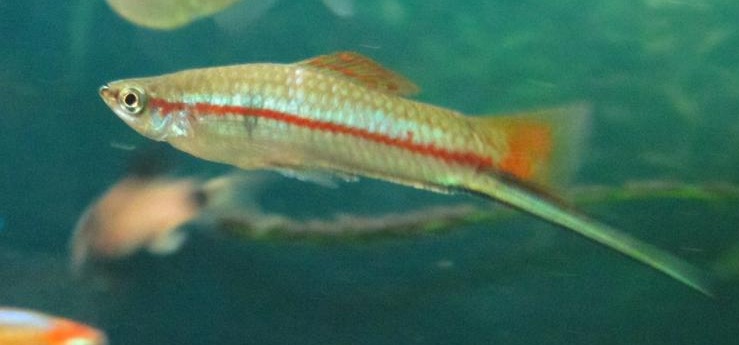
Xiphophorus hellerii; Green Swordtail; Local Common Names // Nom local commun: Cere
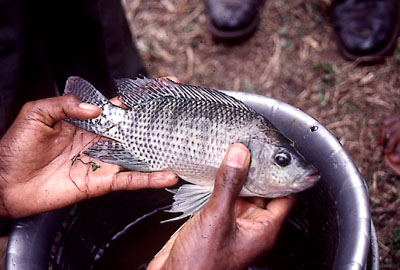
Oreochromis niloticus; Nile Tilapia; Local Common Names // Nom local commun: Nila

Amphilophus labiatus; Red Devil; Local Common Names // Nom local commun: Red Devil
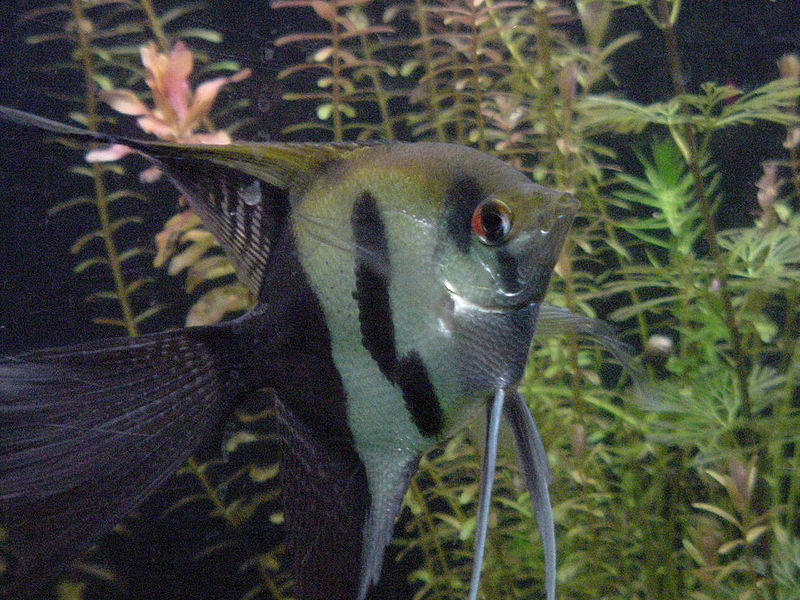
Pterophyllum scalare; Angel Fish; Local Common Names // Nom local commun: Angel Fish
*************************
2.2.3 - A Study on Estimated Loss of Bio-Diversity - Fish
Ciliwung River

According to several literatures (Weber & de Beaufort, 1913, 1916, 1921, 1922, 1929, 1931, 1936; Koumans, 1953), it was known that 187 species of fish lived in Ciliwung River area during 1910s. However, in 2009 only 187 species of fish were recorded and 5 among them were alien fish. This research uncovers 23 species of fish, with 6 among them are alien .
Not all of these fish are freshwater fish, so after some categorising, 103 species of fish caught are categorised as freshwater species. This table shows that in 2010, there's a loss of 84.5% of fish species in Ciliwung River area. This number is less than that of river area, which has 92.5% loss.
According to a specimen study, it is discovered that one alien fish species was first observed in general waters in 1970. In 1990, this number rose to 5. And in 2010, 6 alien species are observed in general waters.
-----
Selon plusieurs littératures (Weber & de Beaufort, 1913, 1916, 1921, 1922, 1929, 1931, 1936; Koumans, 1953), il était connu que 187 espèces de poissons vivent dans Ciliwung région de la rivière au cours années 1910. Cependant, en 2009 seulement 187 espèces de poissons ont été enregistrés et 5 d'entre eux étaient des poissons exotiques. Cette recherche révèle 23 espèces de poissons, avec 6 d'entre eux sont étrangers.
Pas tous ces poissons sont des poissons d'eau douce, donc après un certain classement, 103 espèces de poissons capturés sont classés comme espèces d'eau douce. Ce tableau montre qu'en 2010, il ya une perte de 84,5% des espèces de poissons dans Ciliwung région de la rivière. Ce nombre est inférieur à celui de la zone rivière, qui présente une perte 92,5%.
Selon une étude exemplaire, il est découvert qu'une espèce de poissons exotiques a d'abord été observée dans les eaux générales en 1970. En 1990, ce nombre a augmenté à 5. Et en 2010, 6 espèces exotiques sont observées dans les eaux générales.
Cisadane River

According to literature studies, there were 135 species of fish that lived in Cisadane River area in the 1910s. However, in 2009 only 33 native fish species were recorded, 6 of them were alien fish species. In 2010, 31 native fish species were found, 7 of them were alien. This research shows that 74.4% of fish species are lost in Cisadane pond areas, a bit fewer than the loss in the river area, which is 75.6%.
--------
Selon des études de littérature, il y avait 135 espèces de poissons qui vivaient dans la région du fleuve Cisadane dans les années 1910. Cependant, en 2009 seulement 33 espèces de poissons indigènes ont été enregistrés, 6 d'entre eux étaient des espèces de poissons exotiques. En 2010, 31 espèces de poissons indigènes ont été trouvés, 7 d'entre eux étaient étrangers. Cette recherche montre que 74,4% des espèces de poissons sont perdues dans les zones d'étang Cisadane, un peu moins que la perte dans la région de la rivière, ce qui est de 75,6%.
********
There is a quite delightful result from the research done in ponds within Ciliwung river area. During the research, we managed to discover fish species that couldn't be obtained from the river nor its streams such as the Clown Featherback fish, Notopterus notopterus. This type of fish has been gone from Indonesian rivers hence it is a protected species. Another native fish species that was found was Marbled Sleeper Goby, Oxyeleotris marmorata.
As with all good news, there is also some bad news. This research discovered that Collossoma cf macropomus or Black Body Pacu was found in the river. This kind of fish is a family of Piranha (Serrasalmus spp), which is illegal to enter Indonesian waters. Even though this species isn't as dangerous as its family, its very existence has disturbed the native bio diversity of the pond.
One of the reasons why there are many alien fish species in the region is because there have been events of spreading fish fry into the river, both by a governmental and non-governmental agencies, in an effort to save the river. However, they don't spread native fish species, but alien species such as Nile Tilapia (Oreochromis nicolatus), Common carp (Cyprinus carpio), and Mozzambiq Tilapia (Oreochromis mossambiqus). And other fish such as Esomus cf. metallicus and Amphilophus citrinellus are spreading water system from ornamental fishkeeping..
For example, in May 2010, there was an event in Cilalay small lake, where the commitees decided to spread nile tilapia into the river. This is certainly an alien species to this pond hence the team had been adviced them to spread Pearl Gourami (Trichogaster leeri) which had been lost althought it was the native species of the river..
---------
[color=orange] Il ya un résultat tout à fait délicieux de la recherche effectuée dans les étangs au sein de Ciliwung région de la rivière. Au cours de la recherche, nous avons réussi à découvrir des espèces de poissons qui n'ont pas pu être obtenus à partir de la rivière, ni ses cours d'eau tels que le poisson clown featherback, Notopterus notopterus . Ce type de poisson a été passé de rivières indonésiennes par conséquent, il est une espèce protégée. Une autre espèce de poissons indigènes qui ont été trouvés a été Goby Sleeper marbrée, Oxyeleotris marmorata .
Comme avec toutes les bonnes nouvelles, il ya aussi quelques mauvaises nouvelles. Cette recherche a découvert que Collossoma cf macropomus ou corps noir Pacu a été trouvé dans la rivière. Ce genre de poisson est une famille de Piranha ( Serrasalmus spp ), ce qui est illégal d'entrer dans les eaux indonésiennes. Même si cette espèce n'est pas aussi dangereux que sa famille, son existence même a perturbé la diversité bio natif de l'étang.
Une des raisons pour lesquelles il existe de nombreuses espèces de poissons exotiques dans la région est parce qu'il ya eu des événements de propagation alevins dans la rivière, à la fois par quelques agences gouvernementales et non gouvernementales, dans un effort pour sauver la rivière. Cependant, ils n'ont pas la propagation d'espèces de poissons indigènes, mais les espèces exotiques telles que le tilapia du Nil ( Oreochromis nicolatus ), la carpe commune ( Cyprinus carpio ), et Mozzambiq Tilapia ( Oreochromis mossambiqus ). Et d'autres poissons tels que cf Esomus. metallicus et Amphilophus citrinellus se répandent système d'eau de l'aquariophilie ornementale ..
Par exemple, en mai 2010, il y avait un événement dans Cilalay petit lac, où les comités de décidé d'étendre le tilapia du Nil dans la rivière. Ce n'est certainement une espèce exotique à cet étang où l'équipe avait été averti à répandre Perle Gourami ( Trichogaster leeri ) qui avait été perdu Althought ce sont les espèces indigènes de la rivière ..
******************
Reference:
1. Boldsystems - http://www.boldsystems.org/views/taxbrowser.php?taxid=1144
2. Aquatoyou - http://www.aquatoyou.com/index.php/en/component/content/article/38-2010-01-09-02-26-45/squid/332-2010-02-27-13-14-54
3. aquariumphoto - http://www.aquariumphoto.dk/puntius_binotatus.htm
4. Planet Catfish - http://www.planetcatfish.com/catelog/image.php?species=glyptothorax+platypogon&image_id=6970
5. Fishbase - http://www.fishbase.us/Photos/PicturesSummary.php?ID=4756&what=species
6. Dingo Spike's post Istorya Forum - http://www.istorya.net/forums/pet-discussions/134681-aquatic-cebu-enthusiasts-ace-1803.html
7. Animal Earth - http://animal-earth.com/forum/index.php?showtopic=165
8. Habitat News - http://habitatnews.nus.edu.sg/guidebooks/freshfish/text/228.htm
9. Loaches.com - http://www.loaches.com/species-index/kottelatlimia-pristes
10. Planet Catfish - http://www.planetcatfish.com/catelog/image.php?species=ompok+bimaculatus&image_id=2021
11. Fishbase - http://www.fishbase.us/summary/Glossogobius-giuris.html
12. Mazapura - http://mazapura.com/shop/gobiidae/2478--.html
13. Fishbase - http://www.fishbase.us/summary/Channa-striata.html
 Re: Ciliwung and Cisadane River, Indonesia in a Brink of Destruction
Re: Ciliwung and Cisadane River, Indonesia in a Brink of Destruction
2012-05-27, 11:37 pm
2.3 Amphibi / Amphibi
2.3.1During the observation period, 5 amphibians species were found in Ciliwung lake basins. These are 1 frog species, 2 toad species, and 2 kongkang species: Duttaphrynus melanostictus, Fejervarya cancrivora, Fejervarya limnocharis, Hylarana chalconota, and Hylarana erythraea
------------
Au cours de la période d'observation, 5 espèces d'amphibiens ont été trouvés dans Ciliwung bassins lacustres. Ce sont des espèces de grenouilles 1, 2 espèces de crapauds, et 2 espèces kongkang: Duttaphrynus melanostictus, Fejervarya cancrivora, Fejervarya limnocharis, Hylarana chalconota, and Hylarana erythraea
********************
2.3.2While in Cisadane lake basins were found 8 species of amphibians, consisting of 2 species of frogs, 2 species of toads, 3 species of kongkang, and 1 species of bancet: Duttaphrynus melanostictus, Fejervarya cancrivora, Fejervarya limnocharis, Hylarana chalconota, Hylarana erythraea, Hylarana nicobariensis, Ingerophrynus biporcatus, and Occidozyga sumatrana
------------
Alors que dans les bassins lacustres Cisadane ont été trouvés 8 espèces d'amphibiens, composées de 2 espèces de grenouilles, de crapauds 2 espèces, 3 espèces de kongkang et 1 espèce de bancet: Duttaphrynus melanostictus, Fejervarya cancrivora, Fejervarya limnocharis, Hylarana chalconota, Hylarana erythraea, Hylarana nicobariensis, Ingerophrynus biporcatus, and Occidozyga sumatrana
*************************
2.3.3 - A Study on Estimated Loss of Bio-Diversity - Amphibi
According to the observation of herpetofauna in several Ciliwung lake basins (12 locations) and Cisadane (26 locations) there is a gap of data collected for amphibians. More amphibians were found in Cisadane lake basins compared to Ciliwung lake basins. This data gap is caused by a reduction in habitat where the ampbhians live and reproduce. All in all, it means that the habitat condition in Cisadane lake basins is better than in Ciliwung lake basins. Six amphibians (Duttaphrynus me/anostictus, Fejervarya cancrivora, F. limnocharis, Hylarana chalconota, and H. erythraea) are types of amphibians that like to adapt with human environment. Only one marsh bancet that was found, which actually has a uniqueness of living in swamps or paddy fields that are well irigated.
Kodok buduk (Duttaphrynus melanostictus) is a dominant amphibians in almost every lake habitat. This frog species is able to live in rain water or land that has small pools of rain water. However, it can only live in plains that is no more than 500 m above the sea level. With its big body size and thick skin, this species is able to live in almost all habitats. Unlike a forest puru frog (lngerophrynus biporcatus), this species is very selective in choosing its habitat. Lake Gede (Situ/Danau Gede) that is within the vicinity of CIFOR forest Bogor is an ideal place for this species to reproduce.
Katak sawah (Fejervarya cancrivora) and katak tegalan (F. limnocharis) can live side by side with humans in residental areas such as villages that are located near the lakes. These types of toads can live although the stream isn't very strong and there is a lot of intervention from domestic waste.
Another dominant amphibian species is kongkang kolam (Hylarana chalconota) and kongkang gading (H. erythraea) also spread equally in several lakes. Thus, it can be concluded that both species are still quite tolerant with the changes of their habitat. Kongkang kolam is a type that will survive living in residental areas with heights up to 1,200 m above the sea level. However, when compared with kodok buduk in individual numbers, kongkang gading is less and less encountered in cities. This can be caused by its immunity that isn't very tolerant to sun radiation and heat that were caused by the glass house effects in cities.
Kongkang jangkrik (H. nicobariensis) and marsh bancet (Occidozyga sumatrana) were found in relatively small number because the observatory location had turned into residental areas. Their native habitats were swamps, paddy fields, and small ponds. The more we go into the plains, the less encountered these species were. There's a possibility that their lakes which used to house them had become polluted by toxic waste.
-------------------
Selon l'observation de l'herpétofaune dans plusieurs bassins lacustres Ciliwung (12 emplacements) et Cisadane (26 emplacements), il ya un écart de données recueillies pour les amphibiens. Plus d'amphibiens ont été trouvés dans les bassins lacustres Cisadane par rapport à Ciliwung bassins lacustres. Cette lacune dans les données est causée par une réduction de l'habitat où la ampbhians vivre et se reproduire. Dans l'ensemble, cela signifie que la condition de l'habitat dans les bassins lacustres Cisadane est meilleure que dans les bassins lacustres Ciliwung. Six amphibiens (Duttaphrynus moi / anostictus, Fejervarya cancrivora, F. limnocharis, Hylarana chalconota, et H. erythraea) sont des types d'amphibiens qui aiment à s'adapter à l'environnement humain. Seul un marais bancet qui a été trouvé, qui a fait un caractère unique de la vie dans les marais ou les rizières qui sont bien irigated.
Kodok buduk (Duttaphrynus melanostictus) est un des amphibiens dominante dans presque tous les habitats du lac. Cette espèce de grenouille est capable de vivre dans l'eau de pluie ou de terre qui a de petites mares d'eau de pluie. Cependant, il ne peut vivre que dans les plaines qui ne dépasse pas 500 m au-dessus du niveau de la mer. Avec sa taille grand corps et la peau épaisse, cette espèce est capable de vivre dans presque tous les habitats. Contrairement à une grenouille forêt puru (lngerophrynus biporcatus), cette espèce est très sélectif dans le choix de son habitat. Lac Gede (In Situ / Danau Gede) qui se trouve dans le voisinage de CIFOR à Bogor est un endroit idéal pour cette espèce de se reproduire.
Katak sawah (Fejervarya cancrivora) et katak tegalan (F. limnocharis) peuvent vivre côte à côte avec les humains dans zones résidentielles telles que les villages qui sont situés à proximité des lacs. Ces types de crapauds peut vivre même si le flux n'est pas très forte et il ya beaucoup d'intervention à partir de déchets domestiques.
Une autre espèce dominante amphibie est kongkang kolam (Hylarana chalconota) et kongkang Gading (H. erythraea) également réparti de manière égale dans plusieurs lacs. Ainsi, il peut être conclu que les deux espèces sont encore très tolérant avec les changements de leur habitat. Kongkang kolam est un type qui va survivre dans zones résidentielles avec des hauteurs allant jusqu'à 1200 m au-dessus du niveau de la mer. Cependant, en comparaison avec Kodok buduk dans des numéros individuels, Gading kongkang est de moins en moins rencontré dans les villes. Cela peut être causé par son immunité qui n'est pas très tolérant au rayonnement solaire et la chaleur qui ont été causés par les effets maison de verre dans les villes.
Kongkang jangkrik (H. nicobariensis) et des marais bancet (Occidozyga sumatrana) ont été trouvés en nombre relativement faible parce que l'emplacement observatoire s'était transformé en zones résidentielles. Leurs habitats indigènes étaient des marécages, les rizières, et les petits étangs. Le plus nous avançons dans les plaines, le moins rencontré ces espèces étaient. Il ya une possibilité que leurs lacs qui ont utilisé pour les accueillir était devenu pollué par des déchets toxiques.
******************
Reference:
1. Common Indian Toad (Duttaphrynus melanostictus) - http://whyfiles.org/2010/tracking-traveling-toads/
2. Crab-eating Frog (Fejervarya cancrivora) - http://www.wildsingapore.per.sg/discovery/factsheet/frogcrabeating.htm
3. Grass Frog (Fejervarya limnocharis) - http://www.wildherps.com/species/F.limnocharis.html
4. Brown stream frog (Hylarana chalconota) - http://www.wildborneo.com.my/photo.php?k=peninsular&p=1&i=4
5. Common Greenback (Hylarana erythraea) - http://www.ecologyasia.com/verts/amphibians/common_greenback.htm
6. Nicobar Frog (Hylarana nicobariensis) - http://calphotos.berkeley.edu/cgi/img_query?enlarge=0000+0000+1110+0832
7. Crested Toad (Ingerophrynus biporcatus) - http://homepage.ntlworld.com/bandung/AJfr0ggy/bali/biporcatus.html
8. Sumatran Puddle Frog (Occidozyga sumatrana) - http://calphotos.berkeley.edu/cgi/img_query?enlarge=0000+0000+0110+2481
2.3.1During the observation period, 5 amphibians species were found in Ciliwung lake basins. These are 1 frog species, 2 toad species, and 2 kongkang species: Duttaphrynus melanostictus, Fejervarya cancrivora, Fejervarya limnocharis, Hylarana chalconota, and Hylarana erythraea
------------
Au cours de la période d'observation, 5 espèces d'amphibiens ont été trouvés dans Ciliwung bassins lacustres. Ce sont des espèces de grenouilles 1, 2 espèces de crapauds, et 2 espèces kongkang: Duttaphrynus melanostictus, Fejervarya cancrivora, Fejervarya limnocharis, Hylarana chalconota, and Hylarana erythraea
- Spoiler:

Duttaphrynus melanostictus; Asian Common Toad[1]; Local Common Names // Nom local commun: Kodok Buduk; Bangkong Kolong
This species is famous for it's ribiitt! Ribitt! Sound (literaly oorek-orek-orek-orekk ! in Indonesian Onomotopoeia) and scattered in some countrysides..
Cette espèce est célèbre pour son ribiitt! Ribitt! Sound (littéralement oorek-Orek-Orek-orekk! En indonésien Onomotopoeia) et dispersés dans certains paysages ..
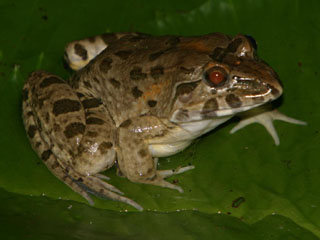
Fejervarya cancrivora; Crab-Eating Frog[2]; Local Common Names // Nom local commun: Katak Sawah (Literaly Paddy Rice Field Frog)
This species of frog is usually used in human consumption especially in Indonesian-Chinese cuisine..
Cette espèce de grenouille est généralement utilisé pour la consommation humaine en particulier en indonésien-cuisine chinoise ..
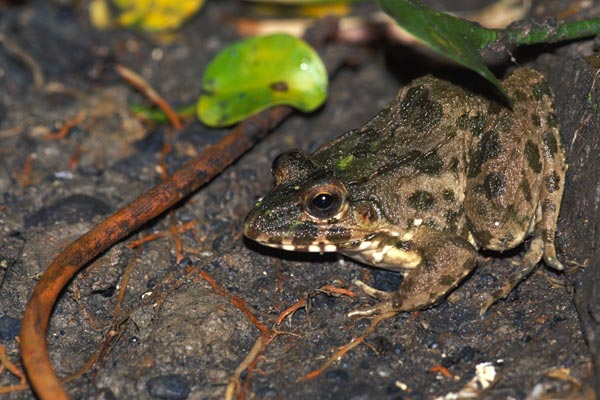
Fejervarya limnocharis; Cricket Frog[3]; Local Common Names // Nom local commun: Katak Tegalan (Literaly Slopped Land Frog)
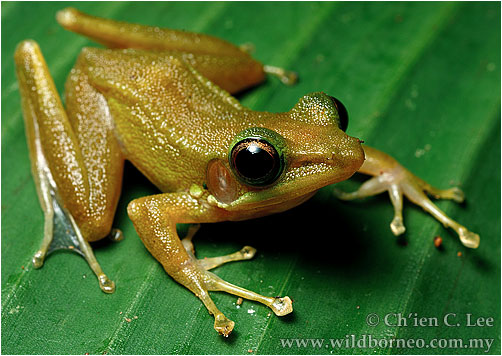
Hylarana chalconota; Schlegel's frog, brown stream frog, copper-cheeked frog, or white-lipped frog[4]; Local Common Names // Nom local commun: Kongkang

Hylarana erythraea; Common Green Frog[5]; Local Common Names // Nom local commun: Katak
********************
2.3.2While in Cisadane lake basins were found 8 species of amphibians, consisting of 2 species of frogs, 2 species of toads, 3 species of kongkang, and 1 species of bancet: Duttaphrynus melanostictus, Fejervarya cancrivora, Fejervarya limnocharis, Hylarana chalconota, Hylarana erythraea, Hylarana nicobariensis, Ingerophrynus biporcatus, and Occidozyga sumatrana
------------
Alors que dans les bassins lacustres Cisadane ont été trouvés 8 espèces d'amphibiens, composées de 2 espèces de grenouilles, de crapauds 2 espèces, 3 espèces de kongkang et 1 espèce de bancet: Duttaphrynus melanostictus, Fejervarya cancrivora, Fejervarya limnocharis, Hylarana chalconota, Hylarana erythraea, Hylarana nicobariensis, Ingerophrynus biporcatus, and Occidozyga sumatrana
- Spoiler:

Duttaphrynus melanostictus; Asian Common Toad[1]; Local Common Names // Nom local commun: Kodok Buduk; Bangkong Kolong
This species is famous for it's ribiitt! Ribitt! Sound (literaly oorek-orek-orek-orekk ! in Indonesian Onomotopoeia) and scattered in some countrysides..
Cette espèce est célèbre pour son ribiitt! Ribitt! Sound (littéralement oorek-Orek-Orek-orekk! En indonésien Onomotopoeia) et dispersés dans certains paysages ..

Fejervarya cancrivora; Crab-Eating Frog[2]; Local Common Names // Nom local commun: Katak Sawah (Literaly Paddy Rice Field Frog)
This species of frog is usually used in human consumption especially in Indonesian-Chinese cuisine..
Cette espèce de grenouille est généralement utilisé pour la consommation humaine en particulier en indonésien-cuisine chinoise ..

Fejervarya limnocharis; Cricket Frog[3]; Local Common Names // Nom local commun: Katak Tegalan (Literaly Slopped Land Frog)

Hylarana chalconota; Schlegel's frog, brown stream frog, copper-cheeked frog, or white-lipped frog[4]; Local Common Names // Nom local commun: Kongkang

Hylarana erythraea; Common Green Frog[5]; Local Common Names // Nom local commun: Katak
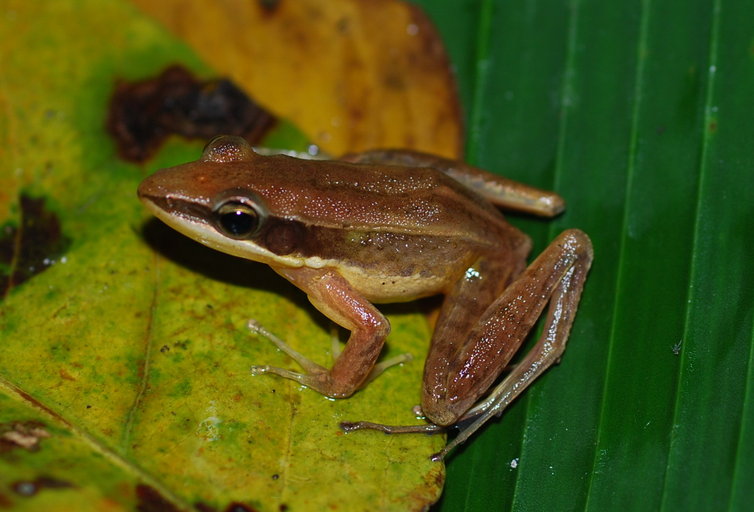
Hylarana nicobariensis; Nicobar Frog[6]; Local Common Names // Nom local commun: Katak
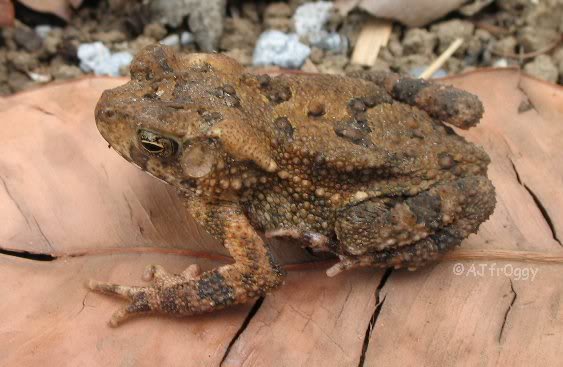
Ingerophrynus biporcatus; Crested Toad[7]; Local Common Names // Nom local commun: Kodok
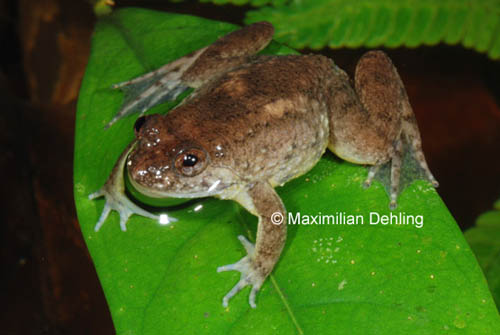
Occidozyga sumatrana; Sumatran puddle frog[8]; Local Common Names // Nom local commun: Bancet Rawa
*************************
2.3.3 - A Study on Estimated Loss of Bio-Diversity - Amphibi
According to the observation of herpetofauna in several Ciliwung lake basins (12 locations) and Cisadane (26 locations) there is a gap of data collected for amphibians. More amphibians were found in Cisadane lake basins compared to Ciliwung lake basins. This data gap is caused by a reduction in habitat where the ampbhians live and reproduce. All in all, it means that the habitat condition in Cisadane lake basins is better than in Ciliwung lake basins. Six amphibians (Duttaphrynus me/anostictus, Fejervarya cancrivora, F. limnocharis, Hylarana chalconota, and H. erythraea) are types of amphibians that like to adapt with human environment. Only one marsh bancet that was found, which actually has a uniqueness of living in swamps or paddy fields that are well irigated.
Kodok buduk (Duttaphrynus melanostictus) is a dominant amphibians in almost every lake habitat. This frog species is able to live in rain water or land that has small pools of rain water. However, it can only live in plains that is no more than 500 m above the sea level. With its big body size and thick skin, this species is able to live in almost all habitats. Unlike a forest puru frog (lngerophrynus biporcatus), this species is very selective in choosing its habitat. Lake Gede (Situ/Danau Gede) that is within the vicinity of CIFOR forest Bogor is an ideal place for this species to reproduce.
Katak sawah (Fejervarya cancrivora) and katak tegalan (F. limnocharis) can live side by side with humans in residental areas such as villages that are located near the lakes. These types of toads can live although the stream isn't very strong and there is a lot of intervention from domestic waste.
Another dominant amphibian species is kongkang kolam (Hylarana chalconota) and kongkang gading (H. erythraea) also spread equally in several lakes. Thus, it can be concluded that both species are still quite tolerant with the changes of their habitat. Kongkang kolam is a type that will survive living in residental areas with heights up to 1,200 m above the sea level. However, when compared with kodok buduk in individual numbers, kongkang gading is less and less encountered in cities. This can be caused by its immunity that isn't very tolerant to sun radiation and heat that were caused by the glass house effects in cities.
Kongkang jangkrik (H. nicobariensis) and marsh bancet (Occidozyga sumatrana) were found in relatively small number because the observatory location had turned into residental areas. Their native habitats were swamps, paddy fields, and small ponds. The more we go into the plains, the less encountered these species were. There's a possibility that their lakes which used to house them had become polluted by toxic waste.
-------------------
Selon l'observation de l'herpétofaune dans plusieurs bassins lacustres Ciliwung (12 emplacements) et Cisadane (26 emplacements), il ya un écart de données recueillies pour les amphibiens. Plus d'amphibiens ont été trouvés dans les bassins lacustres Cisadane par rapport à Ciliwung bassins lacustres. Cette lacune dans les données est causée par une réduction de l'habitat où la ampbhians vivre et se reproduire. Dans l'ensemble, cela signifie que la condition de l'habitat dans les bassins lacustres Cisadane est meilleure que dans les bassins lacustres Ciliwung. Six amphibiens (Duttaphrynus moi / anostictus, Fejervarya cancrivora, F. limnocharis, Hylarana chalconota, et H. erythraea) sont des types d'amphibiens qui aiment à s'adapter à l'environnement humain. Seul un marais bancet qui a été trouvé, qui a fait un caractère unique de la vie dans les marais ou les rizières qui sont bien irigated.
Kodok buduk (Duttaphrynus melanostictus) est un des amphibiens dominante dans presque tous les habitats du lac. Cette espèce de grenouille est capable de vivre dans l'eau de pluie ou de terre qui a de petites mares d'eau de pluie. Cependant, il ne peut vivre que dans les plaines qui ne dépasse pas 500 m au-dessus du niveau de la mer. Avec sa taille grand corps et la peau épaisse, cette espèce est capable de vivre dans presque tous les habitats. Contrairement à une grenouille forêt puru (lngerophrynus biporcatus), cette espèce est très sélectif dans le choix de son habitat. Lac Gede (In Situ / Danau Gede) qui se trouve dans le voisinage de CIFOR à Bogor est un endroit idéal pour cette espèce de se reproduire.
Katak sawah (Fejervarya cancrivora) et katak tegalan (F. limnocharis) peuvent vivre côte à côte avec les humains dans zones résidentielles telles que les villages qui sont situés à proximité des lacs. Ces types de crapauds peut vivre même si le flux n'est pas très forte et il ya beaucoup d'intervention à partir de déchets domestiques.
Une autre espèce dominante amphibie est kongkang kolam (Hylarana chalconota) et kongkang Gading (H. erythraea) également réparti de manière égale dans plusieurs lacs. Ainsi, il peut être conclu que les deux espèces sont encore très tolérant avec les changements de leur habitat. Kongkang kolam est un type qui va survivre dans zones résidentielles avec des hauteurs allant jusqu'à 1200 m au-dessus du niveau de la mer. Cependant, en comparaison avec Kodok buduk dans des numéros individuels, Gading kongkang est de moins en moins rencontré dans les villes. Cela peut être causé par son immunité qui n'est pas très tolérant au rayonnement solaire et la chaleur qui ont été causés par les effets maison de verre dans les villes.
Kongkang jangkrik (H. nicobariensis) et des marais bancet (Occidozyga sumatrana) ont été trouvés en nombre relativement faible parce que l'emplacement observatoire s'était transformé en zones résidentielles. Leurs habitats indigènes étaient des marécages, les rizières, et les petits étangs. Le plus nous avançons dans les plaines, le moins rencontré ces espèces étaient. Il ya une possibilité que leurs lacs qui ont utilisé pour les accueillir était devenu pollué par des déchets toxiques.
******************
Reference:
1. Common Indian Toad (Duttaphrynus melanostictus) - http://whyfiles.org/2010/tracking-traveling-toads/
2. Crab-eating Frog (Fejervarya cancrivora) - http://www.wildsingapore.per.sg/discovery/factsheet/frogcrabeating.htm
3. Grass Frog (Fejervarya limnocharis) - http://www.wildherps.com/species/F.limnocharis.html
4. Brown stream frog (Hylarana chalconota) - http://www.wildborneo.com.my/photo.php?k=peninsular&p=1&i=4
5. Common Greenback (Hylarana erythraea) - http://www.ecologyasia.com/verts/amphibians/common_greenback.htm
6. Nicobar Frog (Hylarana nicobariensis) - http://calphotos.berkeley.edu/cgi/img_query?enlarge=0000+0000+1110+0832
7. Crested Toad (Ingerophrynus biporcatus) - http://homepage.ntlworld.com/bandung/AJfr0ggy/bali/biporcatus.html
8. Sumatran Puddle Frog (Occidozyga sumatrana) - http://calphotos.berkeley.edu/cgi/img_query?enlarge=0000+0000+0110+2481
 Re: Ciliwung and Cisadane River, Indonesia in a Brink of Destruction
Re: Ciliwung and Cisadane River, Indonesia in a Brink of Destruction
2012-05-27, 11:41 pm
2.4 Reptiles / Reptiles
2.4.1Reptiles found in the lakes basin Ciliwung are as many as 20 species, consisting of 8 snake species, two types of geckos, 4 lizards, 2 types of green-crested lizards, 1 kind of lizard, 1 kind of lizard rays, and two types of flying lizard: Ahaetulla mycterizans, Bronchocela jubata, Bungarus candidus, Calotes versicolor, Cyrtodactylus marmoratus, Dasia olivacea, Dendrelaphis pictus, Draco haematopogon, Draco volans, Enhydris enhydris, Eutropis multifasciata, Gecko gecko, Hemidactylus frenatus, Homalopsis buccata, Naja sputatrix, Sphenomorphus puncticentralis, Sphenomorphus sanctus, Takydromus sexlineatus, Xenochrophis trianguligerus, and Xenochrophis vittatus
------------
Reptiles trouvés dans le bassin des Grands Lacs sont Ciliwung jusqu'à 20 espèces, composée de 8 espèces de serpents, deux types de geckos, des lézards, 4 2 types de vert à aigrettes lézards, 1 espèce de lézard, 1 type de rayons lézard, et deux types de lézard volant: Ahaetulla mycterizans, Bronchocela jubata, Bungarus candidus, Calotes versicolor, Cyrtodactylus marmoratus, Dasia olivacea, Dendrelaphis pictus, Draco haematopogon, Draco volans, Enhydris enhydris, Eutropis multifasciata, Gecko gecko, Hemidactylus frenatus, Homalopsis buccata, Naja sputatrix, Sphenomorphus puncticentralis, Sphenomorphus sanctus, Takydromus sexlineatus, Xenochrophis trianguligerus, and Xenochrophis vittatus
********************
2.4.2As for the reptiles that have been found in the Cisadane lake basin, there were as many as 24 species consisting of six types of snakes, three species of green-crested lizards, 3 types of geckos, 2 types of lizard fly, 5 types of lizards, 1 kind of house lizard, 1 kind of lizard ray, a type of soft-shell turtle, and a type of lizard: Ahaetulla mycterizans, Amyda cartilaginea, Bronchocela jubata, , Calotes versicolor, Cyrtodactylus marmoratus, Dasia olivacea, Dendrelaphis pictus[i], [i]Draco haematopogon, Draco volans, Enhydris enhydris, Eutropis multifasciata, Gehyra mutilata, Gecko gecko, Gonocephalus kuhlii, Hemidactylus frenatus, Lamprolepis smaragdina, Naja sputatrix, Ptyas korros, Python reticulatus, Sphenomorphus puncticentralis, Sphenomorphus sanctus, Takydromus sexlineatus, Varanus bivittatus, and Xenochrophis vittatus
------------
En ce qui concerne les reptiles qui ont été trouvés dans le bassin du lac Cisadane, il y avait jusqu'à 24 espèces composé de six types de serpents, trois espèces de lézards verts à aigrettes, 3 types de geckos, 2 types de mouche lézard, 5 types de lézards, 1 espèce de lézard maison, 1 type de rayons lézard, un type de tortue à carapace molle, et un type de lézard: Ahaetulla mycterizans, Amyda cartilaginea, Bronchocela jubata, , Calotes versicolor, Cyrtodactylus marmoratus, Dasia olivacea, Dendrelaphis pictus[i], [i]Draco haematopogon, Draco volans, Enhydris enhydris, Eutropis multifasciata, Gehyra mutilata, Gecko gecko, Gonocephalus kuhlii, Hemidactylus frenatus, Lamprolepis smaragdina, Naja sputatrix, Ptyas korros, Python reticulatus, Sphenomorphus puncticentralis, Sphenomorphus sanctus, Takydromus sexlineatus, Varanus bivittatus, and Xenochrophis vittatus
2.4.3 - A Study on Estimated Loss of Bio-Diversity - Reptiles
The type of reptile that was found appeared to be a brown chameleon (Calotes versicolor), which actually is not a kind of chameleon that is native to the island of Java. The spread of this species is around Southeast Asia from Myanmar, Thailand, Malaysia, and Vietnam. Those which are found on the island of Java, is likely to come from Sumatra. The spread in Java can be caused by the breeding success due to an abundant food source in the area where these species originated. In Singapore as well as in Indonesia, this chameleon is a threat to population of green-crested lizard (Bronchocela cristatella), because brown chameleon has the competition advantage for food hunting and territory. However, according to literatures, its native deployment is only in Sumatra island and Kalimantan island (Borneo), and the small islands in its vicinity (de Rooij, 1915). It is probably due to the expansion of trade in local reptile market so it spread to the island of Java. Besides, with its high reproduction rate and high survival abilities, this species can survive in human residential area.
In addition, lizard ray (Takydromus sexlineatus) is commonly found in the shrubs area and fields overgrown with weeds near the lake. This lizard is very good for maintaining aquatic ecosystems close to the fields or plantations and crop fields, because it can be act as a predator for insects such as grasshoppers. As you know, uncontrolled grasshoppers can become a nuisance in farms.
In some lakes (or "situ" in Indonesian) several rainbow water snakes (Enhydris Enhydris) were found, which has become quite rare to find in West Java waters. This is due to the increasing number of territorial waters and lakes that have been reduced and lost because of deposition or accumulation of soil. So that the area becomes shallow, and it will be amended into the mainland. Generally, this snake is more commonly found in Central Java or East Java because there are many lakes and rice fields there.
Given of these findings, it would add to the list of endangered fauna species, especially reptiles that are covered in this study. So it is increasingly important to do an action of saving biodiversity in water areas from degradation and loss of territory because of intervention of human interests.
Garden bengkarung (Eutropis multifasciata), is the dominant reptile species that can adapt well to almost any habitat and also can easily adapt to environment that is close to human settlements. While the forest gecko (Cyrtodactylus marmoratus) and forest chameleon (Gonocephalus kuhlii) are found in lakes where this research was located, which is still in the forest on the plateau. Thus, the location can still be said to be good. Weling snake (Bungarus candidus) is the only type of snakes that was found during observations. The existence of these types of snakes show that Cisukabirus is still good, because there is a kind of predator fauna that remain subdued in the food pyramid ecosystems.
An interesting thing that was observed during this research was a pair of Varanus bivittatus even though the lake is at 582 m above sea level. The rapid expansion of human settlements area and the decrease in roaming area do not scare this animal. Some people even regard this animal as the guarding of the lake. This animal can still survive and adapt with human population. Chances are the source of food for them is still abundant in the lake.
Other types of commonly found reptiles in the area are green-crested lizard (Bronchocela jubata), Haphap (Draco volans), house gecko (Gecko gecko), and the house lizard (Hemidactylus frenatus). These types of reptiles are easily found in various habitats such as gardens, fields, rice paddies, to ousing residents. While the types of snakes that have been found are python (Python reticulatus), cobra (Naja sputatrix), cikopo snake (Xenochrophis trianguligerus), Ahaetulla mycterizans and the serpent whisper (Xenochrophis vittatus) although these species at this time are traded as pets
or and the skin is traded as a commodity. However, in the area around Ciliwung and Cisadane lake basins, we still managed to find a number to represent the endemic area, which is a mixture of highland forest to fields in lowlands. Types of Xenochrophis vittatus of which the population as of now in West Java is decreasing, we managed to find in Situ Cilala. In general, these snakes are found more in Central Java or East Java. With these findings, it will add to the list of rare animals especially reptiles that are covered in this research.
In addition, it demonstrates that the settlement and regional infrastructure sector are still a priority compared to the water resources sector. The development is perhaps more easily seen with the successful construction of various infrastructure, while the development in the provision of water resources (i.e. coming from the springs) are still viewed as non-infrastructure investment and the results can be obtained after a long period of time.
The fact is, irrigation facilities were built to support the production of foods crop that will indirectly involve the biodiversity inside the environment. However on the other hand, the ability of a buffer system to support lake basins keeps declining. This will cause the loss of local biodiversity.
********
Le type de reptile qui a été trouvé qui semblait être un caméléon brun (Calotes versicolor), qui est en fait pas une sorte de caméléon qui est originaire de l'île de Java. La propagation de cette espèce est d'environ Asie du Sud-du Myanmar, la Thaïlande, la Malaisie et le Vietnam. Ceux qui se trouvent sur l'île de Java, est susceptible de provenir de Sumatra. La propagation en Java peut être causée par le succès de reproduction en raison d'une abondante source de nourriture dans la zone où ces espèces est originaire. À Singapour, ainsi qu'en Indonésie, ce caméléon est une menace pour la population de vert à aigrettes lézard (Bronchocela cristatella), parce brun caméléon a l'avantage de la concurrence pour la chasse nourriture et le territoire. Toutefois, selon les littératures, son déploiement natif n'est que dans l'île de Sumatra et de Kalimantan île (Bornéo), et les petites îles dans son voisinage (de Rooij, 1915). Il est probablement due à l'expansion du commerce dans le marché local afin de reptile elle s'était propagée à l'île de Java. Par ailleurs, avec son taux de reproduction élevé et les capacités de survie élevés, cette espèce peut survivre dans un quartier résidentiel de l'homme.
En outre, le lézard ray (Takydromus sexlineatus) se trouve couramment dans le domaine des arbustes et des champs envahis par les mauvaises herbes près du lac. Ce lézard est très bon pour le maintien des écosystèmes aquatiques à proximité des champs ou plantations et les champs de cultures, car il peut être agir comme un prédateur d'insectes tels que les sauterelles. Comme vous le savez, les sauterelles incontrôlées peuvent devenir une nuisance dans les fermes.
Dans certains lacs (ou "in situ" en indonésien), plusieurs serpents d'eau rainbow (Enhydris Enhydris) ont été trouvés, ce qui est devenu assez rare de trouver dans les eaux de Java Ouest. Cela est dû à l'augmentation du nombre des eaux territoriales et les lacs qui ont été réduits et perdu à cause de dépôt ou l'accumulation de sol. Alors que la région devient peu profonde, et il sera modifié dans la partie continentale. En règle générale, ce serpent est plus fréquemment rencontrée dans le centre de Java ou Java-Est, car il ya beaucoup de lacs et de champs de riz là-bas.
Compte tenu de ces constatations, il serait ajouter à la liste des espèces de faune menacées d'extinction, notamment de reptiles qui sont couverts dans cette étude. Donc, il est de plus en plus important de faire une action de sauvegarde de la biodiversité dans les zones d'eau de la dégradation et la perte de territoire en raison de l'intervention des intérêts humains.
Jardin bengkarung (Eutropis multifasciata), ce sont les espèces de reptiles dominants qui peuvent s'adapter à presque n'importe quel bien de l'habitat et aussi peut facilement s'adapter à l'environnement qui est à proximité des colonies de l'homme. Alors que le gecko des forêts (Cyrtodactylus marmoratus) et de la forêt caméléon (Gonocephalus kuhlii) se trouvent dans les lacs où cette recherche a été localisé, ce qui est toujours dans la forêt sur le plateau. Ainsi, le lieu peut encore être considérée comme bonne. Weling serpent (Bungarus candidus) est le seul type de serpents qui ont été trouvés lors des observations. L'existence de ces types de serpents montrent que Cisukabirus est encore bon, parce qu'il ya une sorte de faune de prédateurs qui restent soumis dans les écosystèmes pyramide alimentaire.
Une chose intéressante qui a été observé au cours de cette recherche était une paire de Varanus bivittatus même si le lac est à 582 m au-dessus du niveau des mers. L'expansion rapide de la zone des établissements humains et la diminution de l'itinérance zone ne font pas peur de cet animal. Certaines personnes considèrent même cet animal comme le gardiennage du lac. Cet animal peut encore survivre et à s'adapter avec la population humaine. Les chances sont la source de nourriture pour eux est encore abondante dans le lac.
D'autres types de reptiles on trouve couramment dans le domaine sont de couleur verte à aigrettes lézard (Bronchocela jubata), Haphap (Draco volans), maison gecko (Gecko gecko), et le lézard maison (Hemidactylus frenatus). Ces types de reptiles sont faciles à trouver dans les divers habitats tels que les jardins, les champs, les rizières, aux résidents Provisoires sur les Mises. Bien que les types de serpents qui ont été trouvés sont python (Python reticulatus), cobra (Naja sputatrix), cikopo serpent (Xenochrophis trianguligerus), mycterizans Ahaetulla et le chuchotement serpent (Xenochrophis vittatus), bien que ces espèces à cette époque sont commercialisés comme animaux de compagnie ou et la peau est traitée comme une marchandise. Cependant, dans la région de Ciliwung et Cisadane bassins lacustres, nous avons encore réussi à trouver un certain nombre de
représentent la zone d'endémie, qui est un mélange de forêt montagneuse aux champs dans les plaines. Types de Xenochrophis vittatus dont la population dès maintenant dans l'ouest de Java est à la baisse, nous avons réussi à trouver dans Cilala Situ. En général, ces serpents se trouvent plus dans le centre de Java ou Java-Est. Avec ces résultats, il va ajouter à la liste des animaux rares, en particulier les reptiles qui sont couverts dans cette recherche.
En outre, il démontre que le règlement et le secteur de l'infrastructure régionale sont toujours une priorité par rapport au secteur des ressources en eau. La développement est peut-être plus facilement visibles à la construction réussie de diverses infrastructures, tandis que le développement de la fourniture des ressources en eau (c.-à-venant des ressorts) sont encore considérés comme non-investissement dans l'infrastructure et les résultats peuvent être obtenus après une longue période de temps .
Le fait est, les installations d'irrigation ont été construits pour soutenir la production de cultures des aliments qui concernent indirectement la biodiversité dans l'environnement. Cependant, d'autre part, la capacité d'un système tampon pour soutenir les bassins lacustres est en constant recul. Cela entraînera la perte de la biodiversité locale.
******************************
1. Green Vine Snake (Ahaetulla mycterizans) - http://uforest.blogspot.com/2008_09_01_archive.html
2. Green-crested lizard (Bronchocela jubata) - http://www.hippocampus-bildarchiv.com/images/RECFT2284_Bronchocela_jubata.jpg
3. Malayan Krait/Blue Krait (Bungarus candidus) - http://www.udonmap.com/udonthaniforum/venomous-snakes-of-udon-thani-t13053.html
4. Oriental Garden Lizard (Calotes versicolor) - http://www.zoocon.com/Herps/Lizards/
5. Javan Bent-Toed Gecko (Cyrtodactylus marmoratus) - http://haliaster.web.id/shw/en/reptil/gekkonidae/cyrtodactylus-marmoratus
6. Olive Dasia/Olive Tree Skink (Dasia olivacea) - http://www.ecologyasia.com/verts/lizards/olive_tree_skink.htm
7. Painted Bronzeback (Dendrelaphis pictus) - http://www.fobi.web.id/key/Dimar+Adhi+Perdana?g2_itemId=40139
8. Red-barbed Flying Dragon (Draco haematopogon) - http://haliaster.web.id/shw/en/reptil/agamidae/draco-haematopogon
9. Common Gliding Lizard (Draco volans) - http://kids.britannica.com/comptons/art-106819/The-flying-dragon-has-scaly-membranes-on-either-side-of
10. The Rainbow Water Snake (Enhydris enhydris) - http://www.indiansnakes.org/Snakedatabase/smooth-scaled/common_ss_ws/common_smooth_sws.html
11. The East Indian Brown Mabuya (Eutropis multifasciata) - http://travel.mongabay.com/indonesia/images/sulawesi6648.html
12. Tokay Gecko (Gekko gecko) - http://www.dreamstime.com/stock-photos-stock-photos-tokay-gecko-gekko-gecko-image6610073
13. Common House Gecko (Hemidactylus frenatus) - http://djringer.com/photos/v/png-050607/
14. Puff-faced Water Snake (Homalopsis buccata) - http://www.fobi.web.id/key/Homalopsidae,typespec?g2_itemId=10112
15. Javan Spitting Cobra (Naja sputatrix) - http://www.flickriver.com/photos/tags/spittingcobra/interesting/
16. Sphenomorphus puncticentralis - http://www.fobi.web.id/fbi/v/reptil/f-sci/sph-pun/Sphenomorphus-puncticentralis_Plawangan_IT.jpg.html
17. Yellow-Lined Forest Skink (Sphenomorphus sanctus) - http://reptile-database.reptarium.cz/species?genus=Sphenomorphus&species=sanctus
18. The Asian Grass Lizard (Takydromus sexlineatus) - http://www.redtailboa.net/forums/help-me/66377-new-reptile-world-neeed-help-my-long-tailed-lizards.html
19. The Triangle Keelback (Xenochrophis trianguligerus) - http://calphotos.berkeley.edu/cgi/img_query?enlarge=0000+0000+0209+1344
20. Striped Keelback (Xenochrophis vittatus) - http://kalamaria.sweb.cz/druhy/X.vittatus.htm
21. Asiatic Softshell Turtle (Amyda cartilaginea) - http://expedition2010.wordpress.com/2011/01/22/dayaks-and-turtles-in-camp/
22. The Four-Clawed Gecko (Gehyra mutilata) - http://www.geckolist.com/gallery/Gehyra+mutilata/index.php
23. Forest Tree Dragon (Gonocephalus kuhlii) - http://www.inaturalist.org/observations/66861
24. The Emerald Tree Skink (Lamprolepis smaragdina) - http://members.home.nl/corrijskamp/naturebook/animalsofMindanao/emeraldstreeskinkorgreenspottedtreeskinkispottedthisbeautifulcoloredskinkintheearlymorningsunonaconcretewallinpurok4b.html
25. Chinese Ratsnake (Ptyas korros) - http://www.snakesoftaiwan.com/Ptyas%20korros/species_ptyas_korros.htm
26. Asiatic Reticulated Python (Python reticulatus) - http://animaldiversity.ummz.umich.edu/site/resources/Grzimek_herps/Pythonidae/Python_reticulatus.jpg/view.html
27. Two-striped Water Monitor (Varanus salvator bivittatus) - http://fish.2v1.cn/Amphibians/or/20101023/1010232.html
2.4.1Reptiles found in the lakes basin Ciliwung are as many as 20 species, consisting of 8 snake species, two types of geckos, 4 lizards, 2 types of green-crested lizards, 1 kind of lizard, 1 kind of lizard rays, and two types of flying lizard: Ahaetulla mycterizans, Bronchocela jubata, Bungarus candidus, Calotes versicolor, Cyrtodactylus marmoratus, Dasia olivacea, Dendrelaphis pictus, Draco haematopogon, Draco volans, Enhydris enhydris, Eutropis multifasciata, Gecko gecko, Hemidactylus frenatus, Homalopsis buccata, Naja sputatrix, Sphenomorphus puncticentralis, Sphenomorphus sanctus, Takydromus sexlineatus, Xenochrophis trianguligerus, and Xenochrophis vittatus
------------
Reptiles trouvés dans le bassin des Grands Lacs sont Ciliwung jusqu'à 20 espèces, composée de 8 espèces de serpents, deux types de geckos, des lézards, 4 2 types de vert à aigrettes lézards, 1 espèce de lézard, 1 type de rayons lézard, et deux types de lézard volant: Ahaetulla mycterizans, Bronchocela jubata, Bungarus candidus, Calotes versicolor, Cyrtodactylus marmoratus, Dasia olivacea, Dendrelaphis pictus, Draco haematopogon, Draco volans, Enhydris enhydris, Eutropis multifasciata, Gecko gecko, Hemidactylus frenatus, Homalopsis buccata, Naja sputatrix, Sphenomorphus puncticentralis, Sphenomorphus sanctus, Takydromus sexlineatus, Xenochrophis trianguligerus, and Xenochrophis vittatus
- Spoiler:

Ahaetulla mycterizans; Vine Snake[1]; Local Common Names // Nom local commun: Ular Pucuk (Stem Snake)
They are mildly venomous and what is commonly termed as 'rear-fanged' or more appropriately, opisthoglyphous, meaning their enlarged teeth or fangs intended to aid in venom delivery are located in the back of the upper jaw, instead of in the front as they are in vipers or cobras.
Ils sont légèrement venimeux et ce qui est communément qualifié de «arrière-crocs» ou, plus exactement, opisthoglyphous, qui signifie que leurs dents agrandies ou crocs destinés à aider dans la prestation de venin sont situés à l'arrière de la mâchoire supérieure, au lieu de à l'avant comme ils sont chez les vipères ou les cobras

[Bronchocela jubata; Green Crested Lizard[2]; Local Common Names // Nom local commun: Bunglon; Londok
This species of lizard is is largely available in Java as far as I'm concern, but the term Bunglon usually used in misconception with Chameleon because both of them have the mimicry ability which can turn colour.. So, majority of Indonesian are mistaken Bunglon to belong in Chameleon family.
Cette espèce de lézard est en grande partie disponible en Java pour autant que je suis préoccupé, mais le Bunglon terme habituellement utilisé au malentendu avec Chameleon parce que les deux d'entre eux ont la capacité mimétisme qui peut changer de couleur .. Ainsi, la majorité des indonésiens se trompent Bunglon appartenir à la famille Chameleon.

Bungarus candidus; Malayan krait or Blue Krait[3]; Local Common Names // Nom local commun: Ular Suci
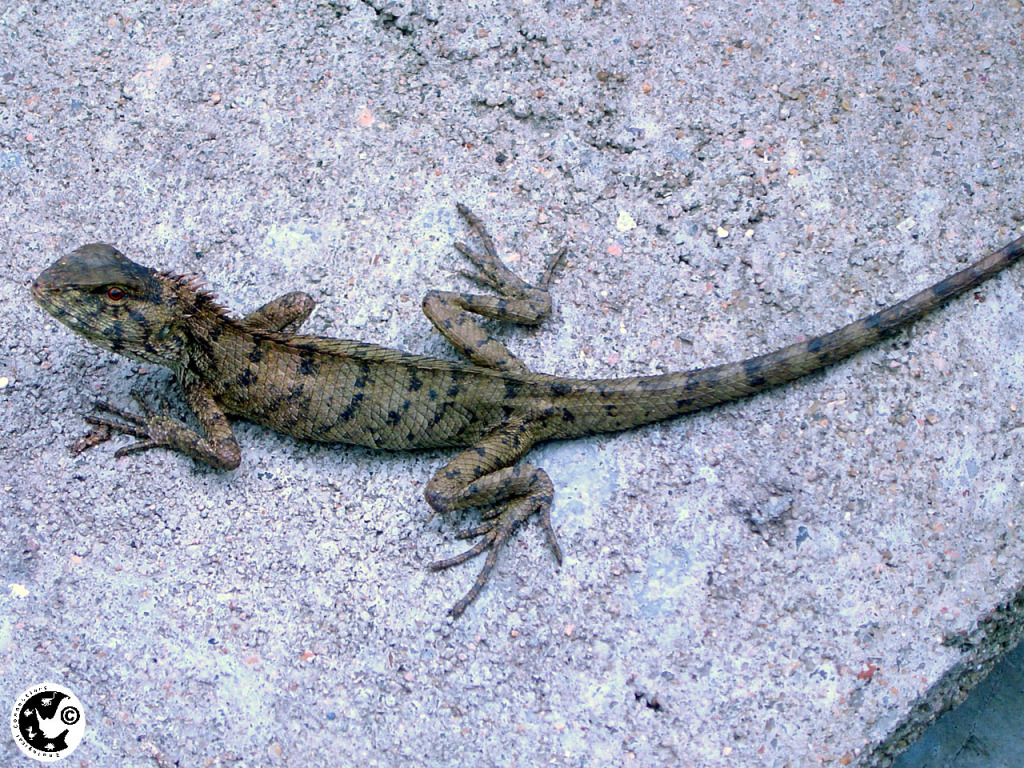
Calotes versicolor; Oriental Garden Lizard[4]; Local Common Names // Nom local commun: Kadal Taman

Cyrtodactylus marmoratus; Javan bent-toed Gecko[5]; Local Common Names // Nom local commun: Cicak Batu (Stone Gecko)
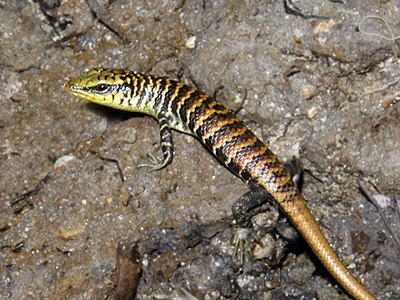
Dasia olivacea; Olive Skink[6]; Local Common Names // Nom local commun: Kadal Pohon Hijau (Green Tree Lizard)
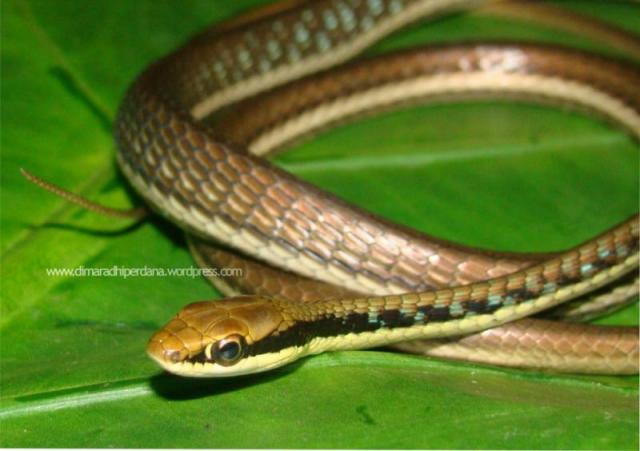
Dendrelaphis pictus; Painted Bronzeback[7]; Local Common Names // Nom local commun: Ular Tambang
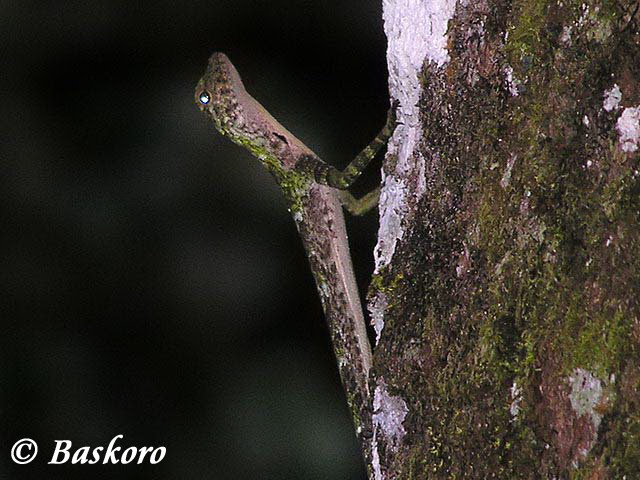
Draco haematopogon; Red Barbel Flying Dragon; Local Common Names // Nom local commun: Cicak Terbang
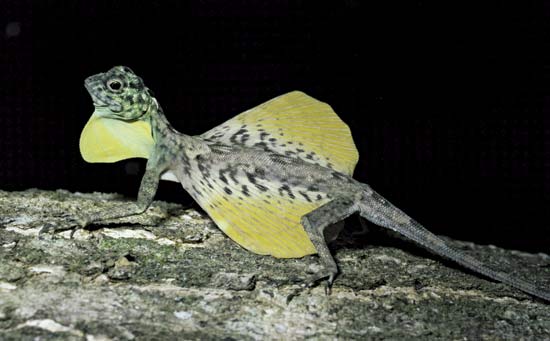
Draco volans; Common Gliding Lizard[9]; Local Common Names // Nom local commun: Cicak Terbang
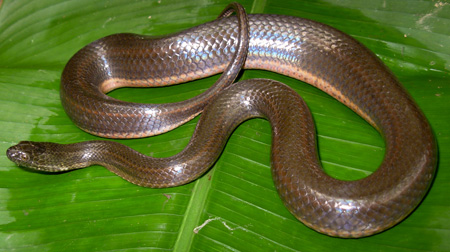
Enhydris enhydris; Rainbow Water Snake[10]; Local Common Names // Nom local commun: Ular Air Pelangi

Eutropis multifasciata; East Indian Mabuya[11]; Local Common Names // Nom local commun: Kadal Kebun
This species of lizard is usually used for predatory fish or reptiles consumption.
Cette espèce de lézard est habituellement utilisé pour les poissons prédateurs ou de la consommation des reptiles
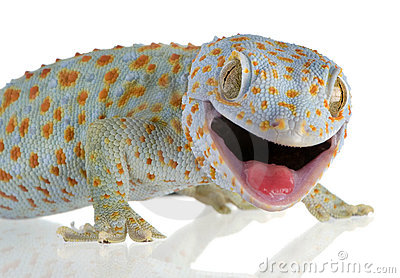
Gecko gecko; Tokay Gecko[12]; Local Common Names // Nom local commun: Tokek Rumah
This is the famous reptiles that has unique "tokke ... tokkee ..." sound..
Ce sont les célèbres reptiles qui a unique "Tokke ... tokkee ..." son ..

Hemidactylus frenatus; Common House Gecko[13]; Local Common Names // Nom local commun: Cicak Kayu
Oh my.. This species is considered as a pest in every home in Indonesia.. They tend to make the house dirty by their poop in the corner of the house..
Oh mon .. Cette espèce est considérée comme un ravageur dans tous les foyers en Indonésie .. Ils ont tendance à salir la maison par leur merde dans le coin de la maison ..
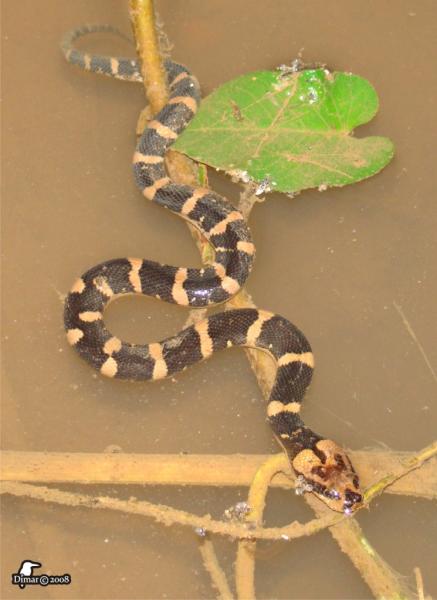
Homalopsis buccata; Puff-faced Water Snake or Masked Water Snakep[14]; Local Common Names // Nom local commun:
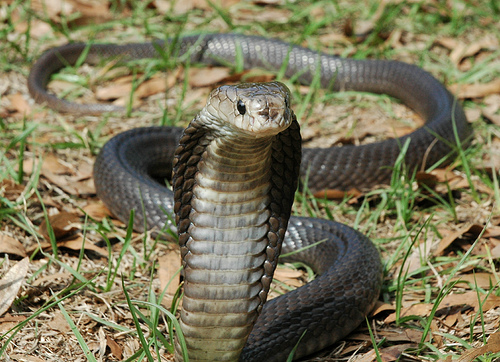
Naja sputatrix; Javan spitting cobra[15]; Local Common Names // Nom local commun: Kobra
Just like in India, you can expect Indonesian usually playing "kissing Cobra show".. And that kinda show is usually found around Banten, West Java
Tout comme en Inde, vous pouvez vous attendre indonésienne en général jouer "show baiser Cobra" .. Et ce spectacle un peu le trouve habituellement autour de Banten, Java-Ouest
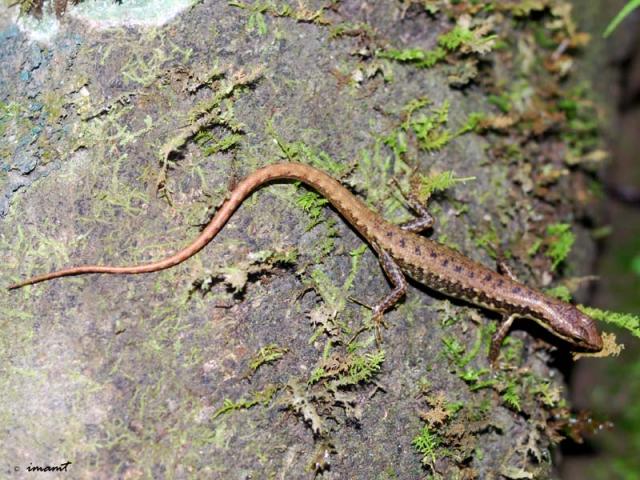
Sphenomorphus puncticentralis; Common Skink[16];Local Common Names // Nom local commun: Kadal

Sphenomorphus sanctus; Common Skink[17]; Local Common Names // Nom local commun: Kadal
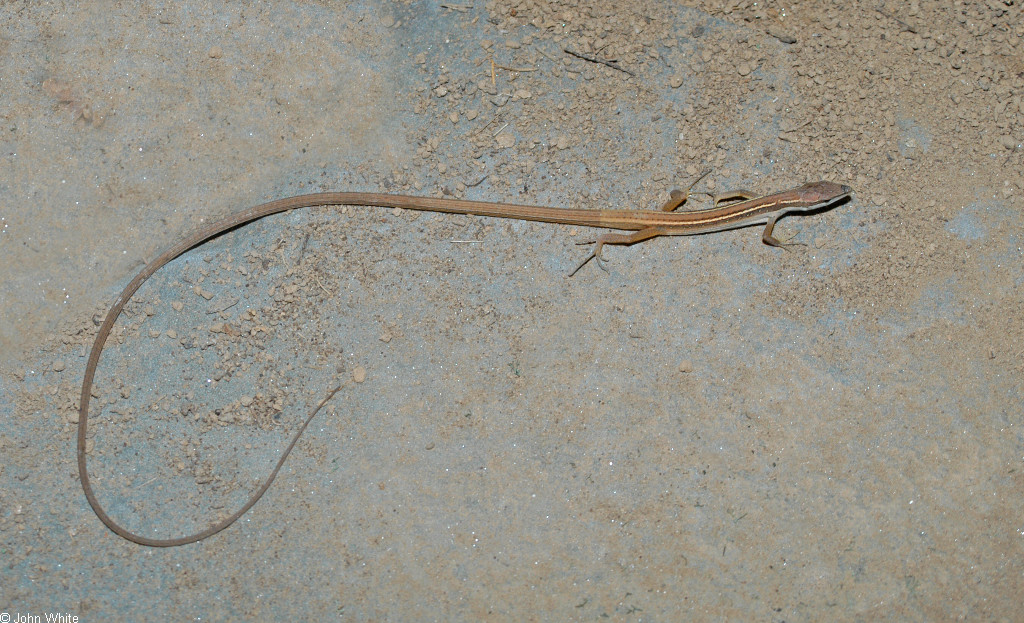
Takydromus sexlineatus; Asian grass lizard[18]; Local Common Names // Nom local commun: Kadal Rumput
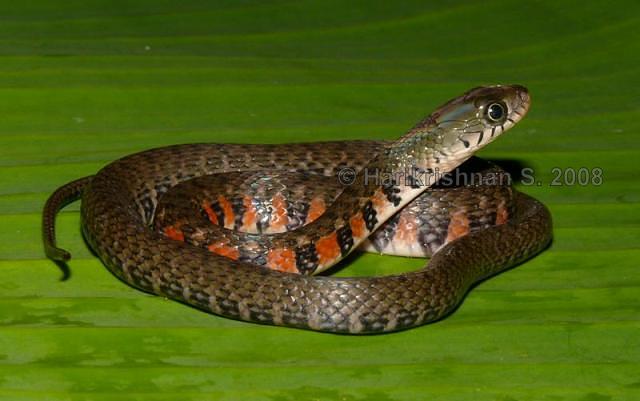
Xenochrophis trianguligerus; Triangle Keelback[19]; Local Common Names // Nom local commun: Ular Segitiga Merah
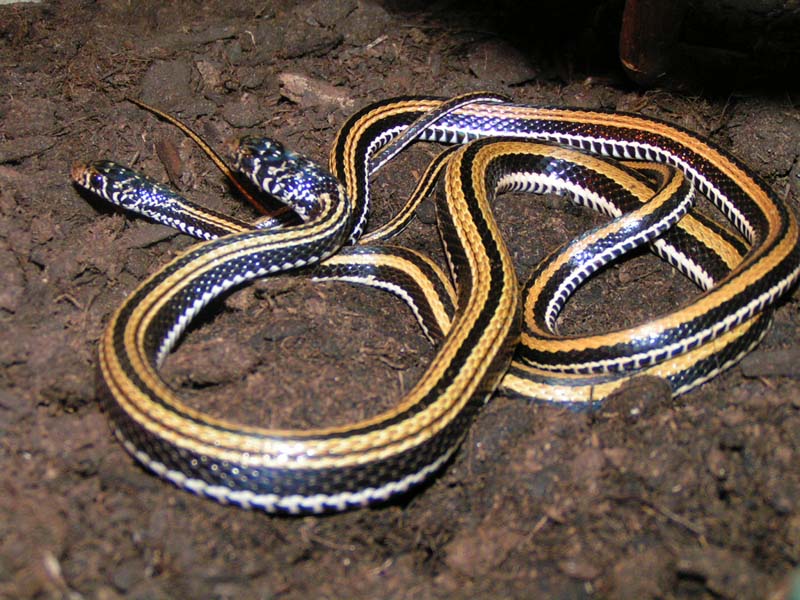
Xenochrophis vittatus; Stripped Keelback[20]; Local Common Names // Nom local commun: Ular Kisik
********************
2.4.2As for the reptiles that have been found in the Cisadane lake basin, there were as many as 24 species consisting of six types of snakes, three species of green-crested lizards, 3 types of geckos, 2 types of lizard fly, 5 types of lizards, 1 kind of house lizard, 1 kind of lizard ray, a type of soft-shell turtle, and a type of lizard: Ahaetulla mycterizans, Amyda cartilaginea, Bronchocela jubata, , Calotes versicolor, Cyrtodactylus marmoratus, Dasia olivacea, Dendrelaphis pictus[i], [i]Draco haematopogon, Draco volans, Enhydris enhydris, Eutropis multifasciata, Gehyra mutilata, Gecko gecko, Gonocephalus kuhlii, Hemidactylus frenatus, Lamprolepis smaragdina, Naja sputatrix, Ptyas korros, Python reticulatus, Sphenomorphus puncticentralis, Sphenomorphus sanctus, Takydromus sexlineatus, Varanus bivittatus, and Xenochrophis vittatus
------------
En ce qui concerne les reptiles qui ont été trouvés dans le bassin du lac Cisadane, il y avait jusqu'à 24 espèces composé de six types de serpents, trois espèces de lézards verts à aigrettes, 3 types de geckos, 2 types de mouche lézard, 5 types de lézards, 1 espèce de lézard maison, 1 type de rayons lézard, un type de tortue à carapace molle, et un type de lézard: Ahaetulla mycterizans, Amyda cartilaginea, Bronchocela jubata, , Calotes versicolor, Cyrtodactylus marmoratus, Dasia olivacea, Dendrelaphis pictus[i], [i]Draco haematopogon, Draco volans, Enhydris enhydris, Eutropis multifasciata, Gehyra mutilata, Gecko gecko, Gonocephalus kuhlii, Hemidactylus frenatus, Lamprolepis smaragdina, Naja sputatrix, Ptyas korros, Python reticulatus, Sphenomorphus puncticentralis, Sphenomorphus sanctus, Takydromus sexlineatus, Varanus bivittatus, and Xenochrophis vittatus
- Spoiler:

Ahaetulla mycterizans; Vine Snake[1]; Local Common Names // Nom local commun: Ular Pucuk (Stem Snake)
They are mildly venomous and what is commonly termed as 'rear-fanged' or more appropriately, opisthoglyphous, meaning
their enlarged teeth or fangs intended to aid in venom delivery are located in the back of the upper jaw, instead of in the front as they are in vipers or
cobras.
Ils sont légèrement venimeux et ce qui est communément qualifié de «arrière-crocs» ou, plus exactement, opisthoglyphous, qui signifie que
leurs dents agrandies ou crocs destinés à aider dans la prestation de venin sont situés à l'arrière de la mâchoire supérieure, au lieu de à l'avant comme
ils sont chez les vipères ou les cobras

Amyda cartilaginea; Asiatic softshell turtle[21]; Local Common Names // Nom local commun: Labi-Labi; Bulus

[Bronchocela jubata; Green Crested Lizard[2]; Local Common Names // Nom local commun: Bunglon; Londok
This species of lizard is is largely available in Java as far as I'm concern, but the term Bunglon usually used in misconception
with Chameleon because both of them have the mimicry ability which can turn colour.. So, majority of Indonesian are mistaken Bunglon to belong in
Chameleon family.
Cette espèce de lézard est en grande partie disponible en Java pour autant que je suis préoccupé, mais le Bunglon terme habituellement
utilisé au malentendu avec Chameleon parce que les deux d'entre eux ont la capacité mimétisme qui peut changer de couleur .. Ainsi, la majorité des
indonésiens se trompent Bunglon appartenir à la famille Chameleon.

Calotes versicolor; Oriental Garden Lizard[4]; Local Common Names // Nom local commun: Kadal Taman

Cyrtodactylus marmoratus; Javan bent-toed Gecko[5]; Local Common Names // Nom local commun: Cicak Batu
(Stone Gecko)

Dasia olivacea; Olive Skink[6]; Local Common Names // Nom local commun: Kadal Pohon Hijau (Green Tree
Lizard)

Dendrelaphis pictus; Painted Bronzeback[7]; Local Common Names // Nom local commun: Ular Tambang

Draco haematopogon; Red Barbel Flying Dragon; Local Common Names // Nom local commun: Cicak Terbang

Draco volans; Common Gliding Lizard[9]; Local Common Names // Nom local commun: Cicak Terbang

Enhydris enhydris; Rainbow Water Snake[10]; Local Common Names // Nom local commun: Ular Air Pelangi

Eutropis multifasciata; East Indian Mabuya[11]; Local Common Names // Nom local commun: Kadal Kebun
This species of lizard is usually used for predatory fish or reptiles consumption.
Cette espèce de lézard est habituellement utilisé pour les poissons prédateurs ou de la consommation des reptiles

Gecko gecko; Tokay Gecko[12]; Local Common Names // Nom local commun: Tokek Rumah
This is the famous reptiles that has unique "tokke ... tokkee ..." sound..
Ce sont les célèbres reptiles qui a unique "Tokke ... tokkee ..." son ..
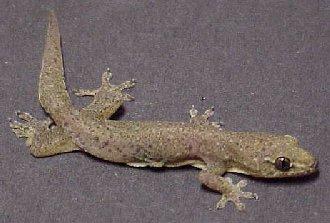
Gehyra mutilata; four-clawed gecko[22]; Local Common Names // Nom local commun: Cicak Gula (Sugar Gecko)
Oh my.. This species is considered as a pest in every home in Indonesia.. They tend to make the house dirty by their poop in the corner of the house..
Oh mon .. Cette espèce est considérée comme un ravageur dans tous les foyers en Indonésie .. Ils ont tendance à salir la maison par leur merde dans le coin de la maison ..

Gonocephalus kuhlii; Forest Tree Dragon[23]; Local Common Names // Nom local commun: Kadal Hutan

Hemidactylus frenatus; Common House Gecko[13]; Local Common Names // Nom local commun: Cicak Kayu
Oh my.. This species is considered as a pest in every home in Indonesia.. They tend to make the house dirty by their poop in
the corner of the house..
Oh mon .. Cette espèce est considérée comme un ravageur dans tous les foyers en Indonésie .. Ils ont tendance à salir la maison par leur
merde dans le coin de la maison ..

Lamprolepis smaragdina; The Emerald Tree Skink[24]; Local Common Names // Nom local commun: Kadal Pohon

Naja sputatrix; Javan spitting cobra[15]; Local Common Names // Nom local commun: Kobra
Just like in India, you can expect Indonesian usually playing "kissing Cobra show".. And that kinda show is usually found
around Banten, West Java
Tout comme en Inde, vous pouvez vous attendre indonésienne en général jouer "show baiser Cobra" .. Et ce spectacle un peu le trouve
habituellement autour de Banten, Java-Ouest
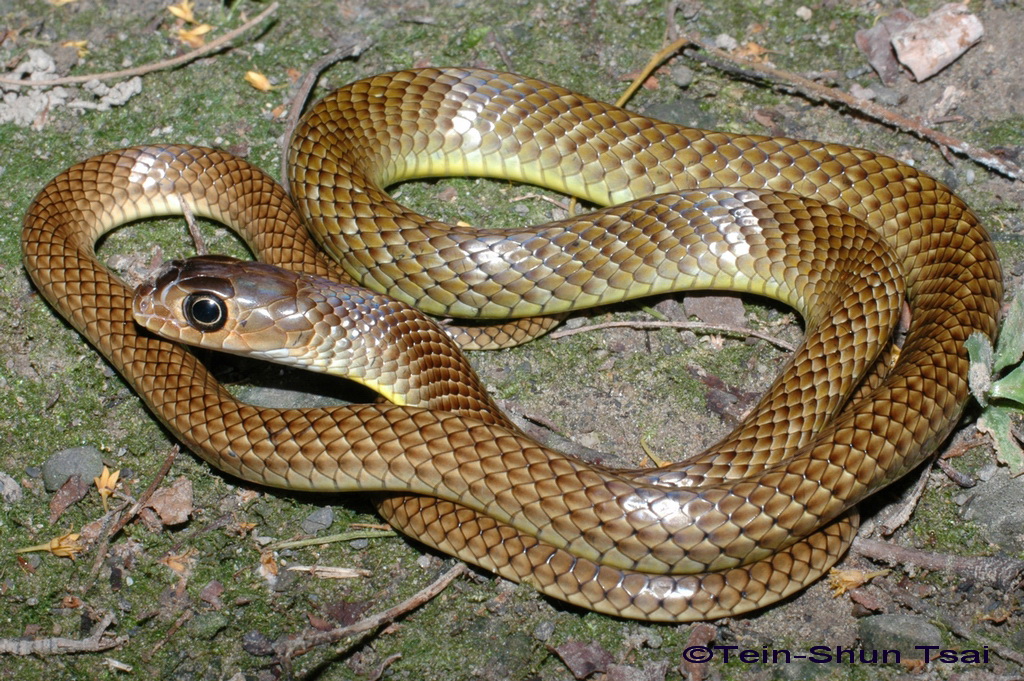
Ptyas korros; Chinese Ratsnake[25]; Local Common Names // Nom local commun: Ular Jali

Python reticulatus; Asiatic reticulated python[26]; Local Common Names // Nom local commun: Ular Piton; Ular Sanca
This famous snake for it's length is always scared Indonesian especially when they enter the house.. Sometimes, if you have trees in your house, the snake can make suprised by fall from the tree and make sound like a burglar broken the house..
Ce serpent célèbre pour sa longueur est toujours peur indonésienne en particulier quand ils entrent dans la maison .. Parfois, si vous avez des arbres dans votre maison, le serpent peut faire surprendre par la chute de l'arbre et de faire sonner comme un cambrioleur cassé la maison ..

Sphenomorphus puncticentralis; Common Skink[16];Local Common Names // Nom local commun: Kadal

Sphenomorphus sanctus; Common Skink[17]; Local Common Names // Nom local commun: Kadal

Takydromus sexlineatus; Asian grass lizard[18]; Local Common Names // Nom local commun: Kadal Rumput
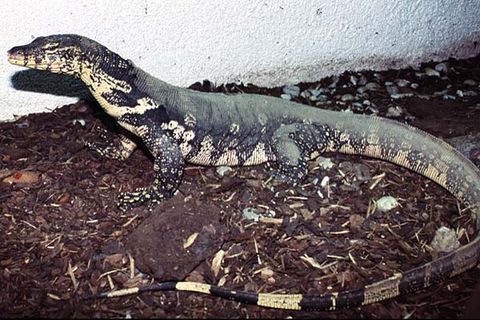
Varanus salvator bittatus; Javanese Water Monitor; Local Common Names // Nom local commun: Biawak

Xenochrophis vittatus; Stripped Keelback[20]; Local Common Names // Nom local commun: Ular Kisik
2.4.3 - A Study on Estimated Loss of Bio-Diversity - Reptiles
The type of reptile that was found appeared to be a brown chameleon (Calotes versicolor), which actually is not a kind of chameleon that is native to the island of Java. The spread of this species is around Southeast Asia from Myanmar, Thailand, Malaysia, and Vietnam. Those which are found on the island of Java, is likely to come from Sumatra. The spread in Java can be caused by the breeding success due to an abundant food source in the area where these species originated. In Singapore as well as in Indonesia, this chameleon is a threat to population of green-crested lizard (Bronchocela cristatella), because brown chameleon has the competition advantage for food hunting and territory. However, according to literatures, its native deployment is only in Sumatra island and Kalimantan island (Borneo), and the small islands in its vicinity (de Rooij, 1915). It is probably due to the expansion of trade in local reptile market so it spread to the island of Java. Besides, with its high reproduction rate and high survival abilities, this species can survive in human residential area.
In addition, lizard ray (Takydromus sexlineatus) is commonly found in the shrubs area and fields overgrown with weeds near the lake. This lizard is very good for maintaining aquatic ecosystems close to the fields or plantations and crop fields, because it can be act as a predator for insects such as grasshoppers. As you know, uncontrolled grasshoppers can become a nuisance in farms.
In some lakes (or "situ" in Indonesian) several rainbow water snakes (Enhydris Enhydris) were found, which has become quite rare to find in West Java waters. This is due to the increasing number of territorial waters and lakes that have been reduced and lost because of deposition or accumulation of soil. So that the area becomes shallow, and it will be amended into the mainland. Generally, this snake is more commonly found in Central Java or East Java because there are many lakes and rice fields there.
Given of these findings, it would add to the list of endangered fauna species, especially reptiles that are covered in this study. So it is increasingly important to do an action of saving biodiversity in water areas from degradation and loss of territory because of intervention of human interests.
Garden bengkarung (Eutropis multifasciata), is the dominant reptile species that can adapt well to almost any habitat and also can easily adapt to environment that is close to human settlements. While the forest gecko (Cyrtodactylus marmoratus) and forest chameleon (Gonocephalus kuhlii) are found in lakes where this research was located, which is still in the forest on the plateau. Thus, the location can still be said to be good. Weling snake (Bungarus candidus) is the only type of snakes that was found during observations. The existence of these types of snakes show that Cisukabirus is still good, because there is a kind of predator fauna that remain subdued in the food pyramid ecosystems.
An interesting thing that was observed during this research was a pair of Varanus bivittatus even though the lake is at 582 m above sea level. The rapid expansion of human settlements area and the decrease in roaming area do not scare this animal. Some people even regard this animal as the guarding of the lake. This animal can still survive and adapt with human population. Chances are the source of food for them is still abundant in the lake.
Other types of commonly found reptiles in the area are green-crested lizard (Bronchocela jubata), Haphap (Draco volans), house gecko (Gecko gecko), and the house lizard (Hemidactylus frenatus). These types of reptiles are easily found in various habitats such as gardens, fields, rice paddies, to ousing residents. While the types of snakes that have been found are python (Python reticulatus), cobra (Naja sputatrix), cikopo snake (Xenochrophis trianguligerus), Ahaetulla mycterizans and the serpent whisper (Xenochrophis vittatus) although these species at this time are traded as pets
or and the skin is traded as a commodity. However, in the area around Ciliwung and Cisadane lake basins, we still managed to find a number to represent the endemic area, which is a mixture of highland forest to fields in lowlands. Types of Xenochrophis vittatus of which the population as of now in West Java is decreasing, we managed to find in Situ Cilala. In general, these snakes are found more in Central Java or East Java. With these findings, it will add to the list of rare animals especially reptiles that are covered in this research.
In addition, it demonstrates that the settlement and regional infrastructure sector are still a priority compared to the water resources sector. The development is perhaps more easily seen with the successful construction of various infrastructure, while the development in the provision of water resources (i.e. coming from the springs) are still viewed as non-infrastructure investment and the results can be obtained after a long period of time.
The fact is, irrigation facilities were built to support the production of foods crop that will indirectly involve the biodiversity inside the environment. However on the other hand, the ability of a buffer system to support lake basins keeps declining. This will cause the loss of local biodiversity.
********
Le type de reptile qui a été trouvé qui semblait être un caméléon brun (Calotes versicolor), qui est en fait pas une sorte de caméléon qui est originaire de l'île de Java. La propagation de cette espèce est d'environ Asie du Sud-du Myanmar, la Thaïlande, la Malaisie et le Vietnam. Ceux qui se trouvent sur l'île de Java, est susceptible de provenir de Sumatra. La propagation en Java peut être causée par le succès de reproduction en raison d'une abondante source de nourriture dans la zone où ces espèces est originaire. À Singapour, ainsi qu'en Indonésie, ce caméléon est une menace pour la population de vert à aigrettes lézard (Bronchocela cristatella), parce brun caméléon a l'avantage de la concurrence pour la chasse nourriture et le territoire. Toutefois, selon les littératures, son déploiement natif n'est que dans l'île de Sumatra et de Kalimantan île (Bornéo), et les petites îles dans son voisinage (de Rooij, 1915). Il est probablement due à l'expansion du commerce dans le marché local afin de reptile elle s'était propagée à l'île de Java. Par ailleurs, avec son taux de reproduction élevé et les capacités de survie élevés, cette espèce peut survivre dans un quartier résidentiel de l'homme.
En outre, le lézard ray (Takydromus sexlineatus) se trouve couramment dans le domaine des arbustes et des champs envahis par les mauvaises herbes près du lac. Ce lézard est très bon pour le maintien des écosystèmes aquatiques à proximité des champs ou plantations et les champs de cultures, car il peut être agir comme un prédateur d'insectes tels que les sauterelles. Comme vous le savez, les sauterelles incontrôlées peuvent devenir une nuisance dans les fermes.
Dans certains lacs (ou "in situ" en indonésien), plusieurs serpents d'eau rainbow (Enhydris Enhydris) ont été trouvés, ce qui est devenu assez rare de trouver dans les eaux de Java Ouest. Cela est dû à l'augmentation du nombre des eaux territoriales et les lacs qui ont été réduits et perdu à cause de dépôt ou l'accumulation de sol. Alors que la région devient peu profonde, et il sera modifié dans la partie continentale. En règle générale, ce serpent est plus fréquemment rencontrée dans le centre de Java ou Java-Est, car il ya beaucoup de lacs et de champs de riz là-bas.
Compte tenu de ces constatations, il serait ajouter à la liste des espèces de faune menacées d'extinction, notamment de reptiles qui sont couverts dans cette étude. Donc, il est de plus en plus important de faire une action de sauvegarde de la biodiversité dans les zones d'eau de la dégradation et la perte de territoire en raison de l'intervention des intérêts humains.
Jardin bengkarung (Eutropis multifasciata), ce sont les espèces de reptiles dominants qui peuvent s'adapter à presque n'importe quel bien de l'habitat et aussi peut facilement s'adapter à l'environnement qui est à proximité des colonies de l'homme. Alors que le gecko des forêts (Cyrtodactylus marmoratus) et de la forêt caméléon (Gonocephalus kuhlii) se trouvent dans les lacs où cette recherche a été localisé, ce qui est toujours dans la forêt sur le plateau. Ainsi, le lieu peut encore être considérée comme bonne. Weling serpent (Bungarus candidus) est le seul type de serpents qui ont été trouvés lors des observations. L'existence de ces types de serpents montrent que Cisukabirus est encore bon, parce qu'il ya une sorte de faune de prédateurs qui restent soumis dans les écosystèmes pyramide alimentaire.
Une chose intéressante qui a été observé au cours de cette recherche était une paire de Varanus bivittatus même si le lac est à 582 m au-dessus du niveau des mers. L'expansion rapide de la zone des établissements humains et la diminution de l'itinérance zone ne font pas peur de cet animal. Certaines personnes considèrent même cet animal comme le gardiennage du lac. Cet animal peut encore survivre et à s'adapter avec la population humaine. Les chances sont la source de nourriture pour eux est encore abondante dans le lac.
D'autres types de reptiles on trouve couramment dans le domaine sont de couleur verte à aigrettes lézard (Bronchocela jubata), Haphap (Draco volans), maison gecko (Gecko gecko), et le lézard maison (Hemidactylus frenatus). Ces types de reptiles sont faciles à trouver dans les divers habitats tels que les jardins, les champs, les rizières, aux résidents Provisoires sur les Mises. Bien que les types de serpents qui ont été trouvés sont python (Python reticulatus), cobra (Naja sputatrix), cikopo serpent (Xenochrophis trianguligerus), mycterizans Ahaetulla et le chuchotement serpent (Xenochrophis vittatus), bien que ces espèces à cette époque sont commercialisés comme animaux de compagnie ou et la peau est traitée comme une marchandise. Cependant, dans la région de Ciliwung et Cisadane bassins lacustres, nous avons encore réussi à trouver un certain nombre de
représentent la zone d'endémie, qui est un mélange de forêt montagneuse aux champs dans les plaines. Types de Xenochrophis vittatus dont la population dès maintenant dans l'ouest de Java est à la baisse, nous avons réussi à trouver dans Cilala Situ. En général, ces serpents se trouvent plus dans le centre de Java ou Java-Est. Avec ces résultats, il va ajouter à la liste des animaux rares, en particulier les reptiles qui sont couverts dans cette recherche.
En outre, il démontre que le règlement et le secteur de l'infrastructure régionale sont toujours une priorité par rapport au secteur des ressources en eau. La développement est peut-être plus facilement visibles à la construction réussie de diverses infrastructures, tandis que le développement de la fourniture des ressources en eau (c.-à-venant des ressorts) sont encore considérés comme non-investissement dans l'infrastructure et les résultats peuvent être obtenus après une longue période de temps .
Le fait est, les installations d'irrigation ont été construits pour soutenir la production de cultures des aliments qui concernent indirectement la biodiversité dans l'environnement. Cependant, d'autre part, la capacité d'un système tampon pour soutenir les bassins lacustres est en constant recul. Cela entraînera la perte de la biodiversité locale.
******************************
1. Green Vine Snake (Ahaetulla mycterizans) - http://uforest.blogspot.com/2008_09_01_archive.html
2. Green-crested lizard (Bronchocela jubata) - http://www.hippocampus-bildarchiv.com/images/RECFT2284_Bronchocela_jubata.jpg
3. Malayan Krait/Blue Krait (Bungarus candidus) - http://www.udonmap.com/udonthaniforum/venomous-snakes-of-udon-thani-t13053.html
4. Oriental Garden Lizard (Calotes versicolor) - http://www.zoocon.com/Herps/Lizards/
5. Javan Bent-Toed Gecko (Cyrtodactylus marmoratus) - http://haliaster.web.id/shw/en/reptil/gekkonidae/cyrtodactylus-marmoratus
6. Olive Dasia/Olive Tree Skink (Dasia olivacea) - http://www.ecologyasia.com/verts/lizards/olive_tree_skink.htm
7. Painted Bronzeback (Dendrelaphis pictus) - http://www.fobi.web.id/key/Dimar+Adhi+Perdana?g2_itemId=40139
8. Red-barbed Flying Dragon (Draco haematopogon) - http://haliaster.web.id/shw/en/reptil/agamidae/draco-haematopogon
9. Common Gliding Lizard (Draco volans) - http://kids.britannica.com/comptons/art-106819/The-flying-dragon-has-scaly-membranes-on-either-side-of
10. The Rainbow Water Snake (Enhydris enhydris) - http://www.indiansnakes.org/Snakedatabase/smooth-scaled/common_ss_ws/common_smooth_sws.html
11. The East Indian Brown Mabuya (Eutropis multifasciata) - http://travel.mongabay.com/indonesia/images/sulawesi6648.html
12. Tokay Gecko (Gekko gecko) - http://www.dreamstime.com/stock-photos-stock-photos-tokay-gecko-gekko-gecko-image6610073
13. Common House Gecko (Hemidactylus frenatus) - http://djringer.com/photos/v/png-050607/
14. Puff-faced Water Snake (Homalopsis buccata) - http://www.fobi.web.id/key/Homalopsidae,typespec?g2_itemId=10112
15. Javan Spitting Cobra (Naja sputatrix) - http://www.flickriver.com/photos/tags/spittingcobra/interesting/
16. Sphenomorphus puncticentralis - http://www.fobi.web.id/fbi/v/reptil/f-sci/sph-pun/Sphenomorphus-puncticentralis_Plawangan_IT.jpg.html
17. Yellow-Lined Forest Skink (Sphenomorphus sanctus) - http://reptile-database.reptarium.cz/species?genus=Sphenomorphus&species=sanctus
18. The Asian Grass Lizard (Takydromus sexlineatus) - http://www.redtailboa.net/forums/help-me/66377-new-reptile-world-neeed-help-my-long-tailed-lizards.html
19. The Triangle Keelback (Xenochrophis trianguligerus) - http://calphotos.berkeley.edu/cgi/img_query?enlarge=0000+0000+0209+1344
20. Striped Keelback (Xenochrophis vittatus) - http://kalamaria.sweb.cz/druhy/X.vittatus.htm
21. Asiatic Softshell Turtle (Amyda cartilaginea) - http://expedition2010.wordpress.com/2011/01/22/dayaks-and-turtles-in-camp/
22. The Four-Clawed Gecko (Gehyra mutilata) - http://www.geckolist.com/gallery/Gehyra+mutilata/index.php
23. Forest Tree Dragon (Gonocephalus kuhlii) - http://www.inaturalist.org/observations/66861
24. The Emerald Tree Skink (Lamprolepis smaragdina) - http://members.home.nl/corrijskamp/naturebook/animalsofMindanao/emeraldstreeskinkorgreenspottedtreeskinkispottedthisbeautifulcoloredskinkintheearlymorningsunonaconcretewallinpurok4b.html
25. Chinese Ratsnake (Ptyas korros) - http://www.snakesoftaiwan.com/Ptyas%20korros/species_ptyas_korros.htm
26. Asiatic Reticulated Python (Python reticulatus) - http://animaldiversity.ummz.umich.edu/site/resources/Grzimek_herps/Pythonidae/Python_reticulatus.jpg/view.html
27. Two-striped Water Monitor (Varanus salvator bivittatus) - http://fish.2v1.cn/Amphibians/or/20101023/1010232.html
 Cagouillard17Administrateur
Cagouillard17Administrateur- Date d'inscription : 06/05/2010
Nombre de messages : 3760
Liste de Maintenance
Mise à jour :: 29/04/2011
 Re: Ciliwung and Cisadane River, Indonesia in a Brink of Destruction
Re: Ciliwung and Cisadane River, Indonesia in a Brink of Destruction
2012-05-27, 11:54 pm
Very interesting as subject;
I just discovered a new vampire green crab with orange eyes from java.
http://travel.mongabay.com/indonesia/images/java/java_0291.html
Très intéressant comme sujet;
Je viens de découvrir un nouveau crabe vampire vert avec les yeux orange provenant de java.
Permission de ce forum:
Vous ne pouvez pas répondre aux sujets dans ce forum
